Splendid Views of Edo~Snow, Moon and Flowers
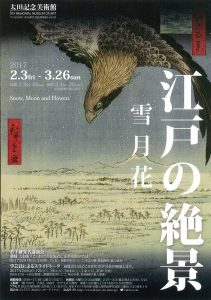
2017, February 3rd ~ March 26th
[1st Term] February 3rd~26th
[2nd Term] March 3rd~26th
※Works change between two terms
(Will be closed on February 6, 13, 20, 27~28 / March 1~2, 6, 13, 21st)
The trend for splendid views existed in Edo, too.
The word “Zekkei (Breathtaking scenery)” was so popular that it was nominated for Buzzwords-of-the-year contest in 2014. While TV shows introducing splendid views both within Japan and abroad are very popular today, it seems that the people of Edo also loved marveling at beautiful scenery. In the latter half of the Edo period, geographical books illustrating famous places along with their histories were published, and an innumerous amount of ukiyo-e works showing picturesque landscapes from Edo and all parts of Japan was created. Artists depicted a wide range of scenery, from seasonal spectacles to unexplored regions and even temples overlooking the secular world from upon a cliff. Furthermore, they actively used imaginary viewpoints – looking down from the sky, for example – and portrayed views that “no one has seen”. In this exhibition, we will exhibit the breathtaking works by Utagawa Hiroshige and other artists, such as Hokusai, Kuniyoshi and more. The exhibit is divided into five sections: “snow” “moon” “flowers” “mountains and waterfronts” and “temples and shrines”. Please enjoy your journey of Japanese Zekkei in this museum.

Utagawa Hiroshige “The Saru-hashi Bridge in Kai Province” (Exhibited in the 2nd term)
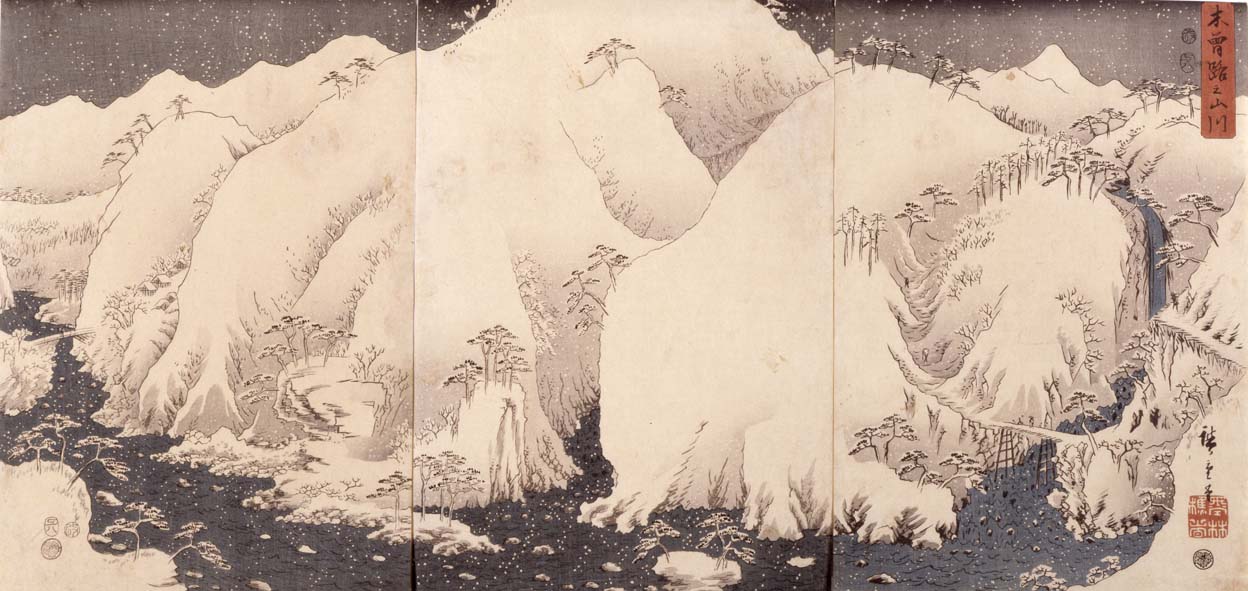
Utagawa Hiroshige “Mountains and Streams in Kiso District” (Exhibited in the 1st and 2nd term)
A Must-see for Edokko: Breathtaking Scenery from around Japan
Many people are mesmerized by breathtaking scenery they see on the Internet or in books, and imagine themselves being there. In the Edo period, people were just as excited to visit scenic spots they had seen in ukiyo-e, such as the cherry blossoms of Kyoto, Kiso-ji in snow and Enoshima surrounded by the blue sea, which are in fact still popular tourist spots. In a time without Shinkansen or airplanes, everyone longed to pay a visit to these scenic places, which would require long and hard travel. Spectacles that have been loved by the Japanese people over the ages come together, with their various seasons.
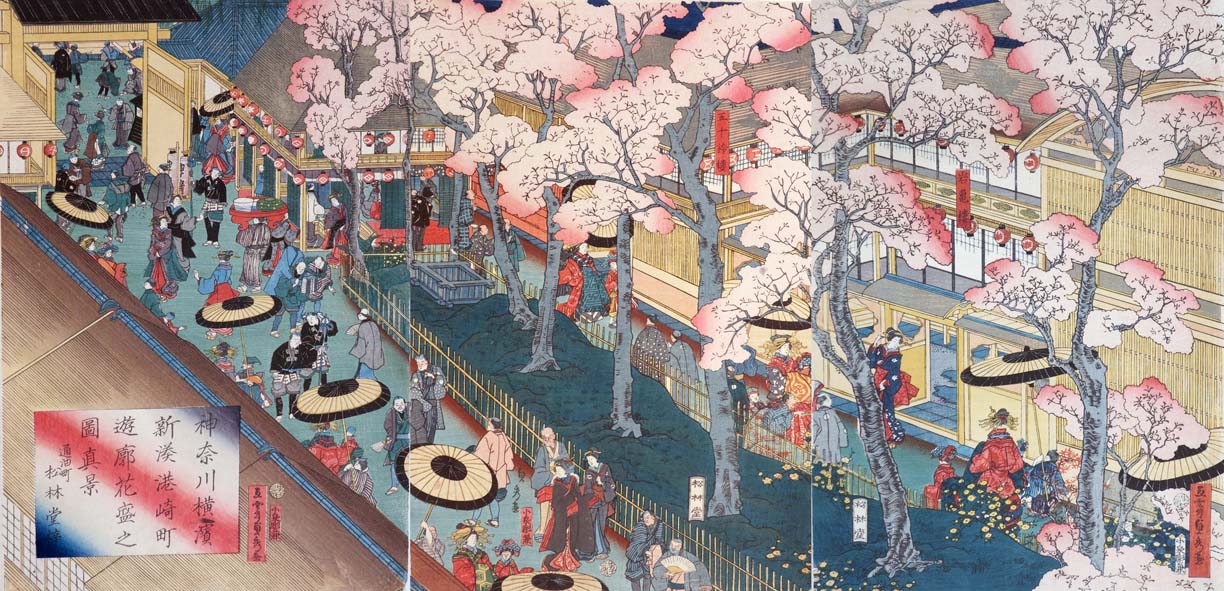
Utagawa Sadahide “Cherry Blossoms in Miyozaki Presure Quarters near Yokohama New Port of Kanagawa” (Exhibited in the 2nd term)
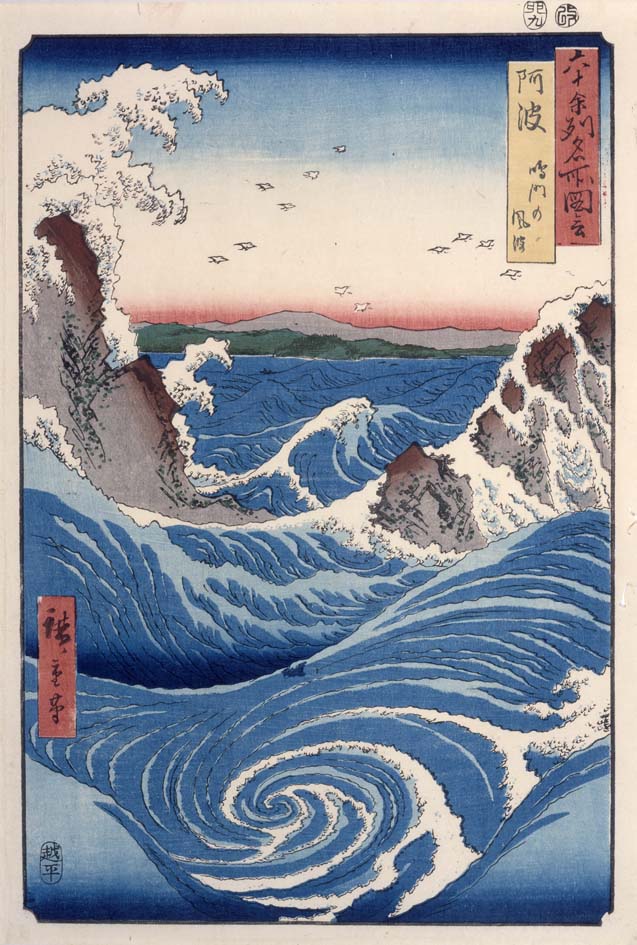
Utagawa Hiroshige “Famous Places in the Sixty-odd Provinces: Naruto Whirlpools at Awa Province “ (Exhibited in the 1st term)
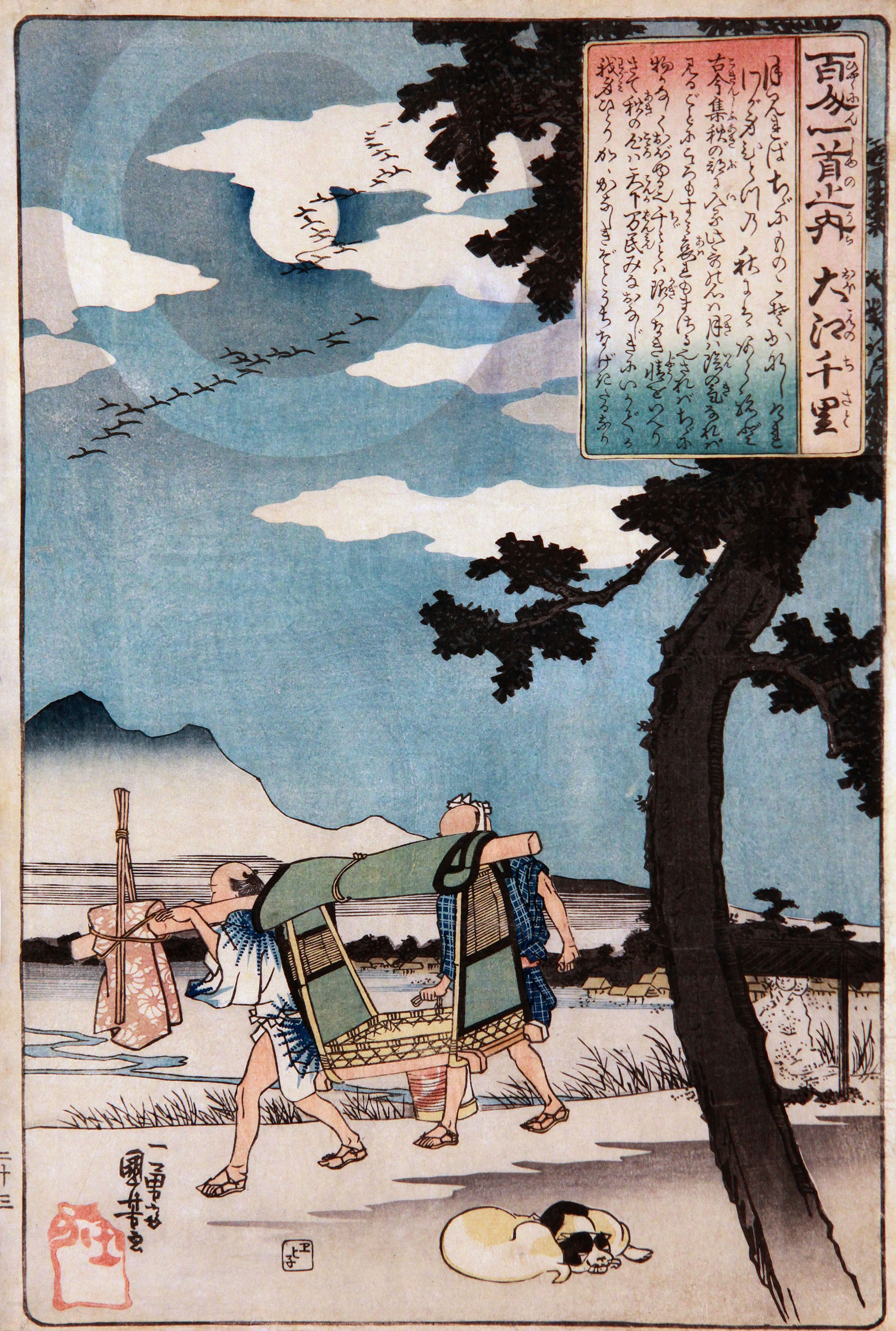
Utagawa Kuniyoshi “One Hundred Poems by One Hundred Poets : Ōe no Chisato” (Exhibited in the 1st term)
Walk of superb views in Edo
The Sumida River in snow, Edo bay basking in the moonlight, and Kanei-ji Temple in cherry blossom season. People in Edo enjoyed various sightseeing spots from season to season, and gazed upon Mt.Fuji from all around the city. The people then were able to enjoy aesthetic scenery that we, living in Tokyo full of skyscrapers, can hardly imagine. Here we exhibit pictures of the scenic places loved by the people of Edo.
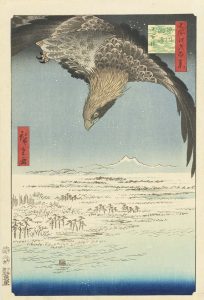
Utagawa Hiroshige “One Hundred Famous Views of Edo: Jūmantsubo at Susaki in Fukagawa” (Exhibited in the 1st term)
Utagawa Hiroshige “One Hundred Famous Views of Edo: The Kiyomizu-dō Temple and Shinobazu Pond at Ueno” (Exhibited in the 1st term)
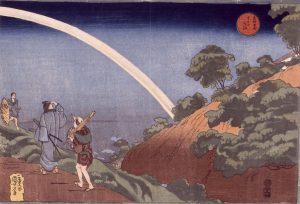
Utagawa Kuniyoshi “Famous Places in the Eastern Capital: Surugadai” (Exhibited in the 2nd term)
<Highlight Work of Exhibition>
Katsushika Hokusai “Unusual Views of Famous Bridges in Various Provinces: The Suspension Bridge on the Border of Hida and Ecchū Provinces”

Hi-etsu is the region around the border between Northern Gifu (Hida) and Toyama (Ecchū). A suspension bridge with no handrail connects the steep mountains. A man and a woman thought to be woodcutters are serenely walking across with their baggage. Trees, birds, and even the haze seem to be supporting their feet, and they look as if they are walking in the air. The stiff bridge behind the woman gives a tense contrast within this mystical view of nature.
Translation Supervised by Japanese Students Association of Princeton University
Admission
| Adult | 700 yen |
|---|---|
| University and High school students | 500 yen |
| Junior High School Students and below | Free |
Calendar
Closed
- 2017, February
SUN MON TUE WED THU FRI SAT 1 2 3 4 5 6 7 8 9 10 11 12 13 14 15 16 17 18 19 20 21 22 23 24 25 26 27 28 - 2017, March
SUN MON TUE WED THU FRI SAT 1 2 3 4 5 6 7 8 9 10 11 12 13 14 15 16 17 18 19 20 21 22 23 24 25 26 27 28 29 30 31
Comical Edo People by Utagawa Hirokage
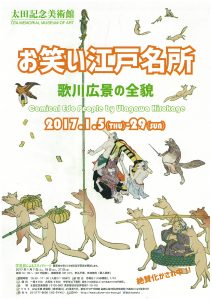
2017, January 5th~January 29th
(Will be closed on January 10, 16, 23rd)
Laughing! Joking!! Goofing!!! Silly Edokko Collection
Utagawa Hirokage’s representative work “Comical Views of Famous Places in Edo” playfully depicts Edokko (Edo people) having fun and goofing around in the late Edo period. This exhibition is a valuable opportunity to see all 50 pieces of this series at once. Please enjoy the comical and entertaining pictures of the Edokko, which you cannot often see in the other ukiyo-e exhibitions.
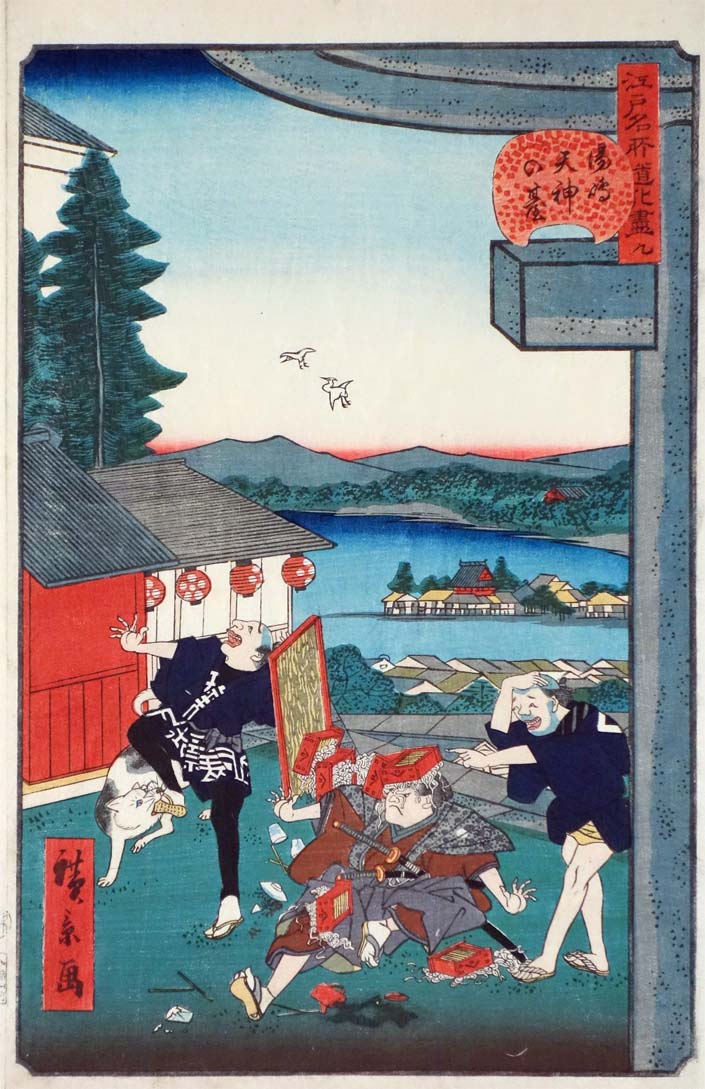
Utagawa Hirokage “Comical Views of Famous Places in Edo : No. 9, Yushima Tenjin Shrine ” (Ota Memorial Museum of Art) A soba noodle shop staff is bitten by a dog. One Samurai is covered with soba noodles intended for delivery.
Utagawa Hirokage “Comical Views of Famous Places in Edo : No. 19, Mitsumata at Shin-Ōhashi Bridge ” (Ota Memorial Museum of Art) Men wearing nothing but a loincloth are jumping from a bridge. They crash into a small boat full of watermelons.
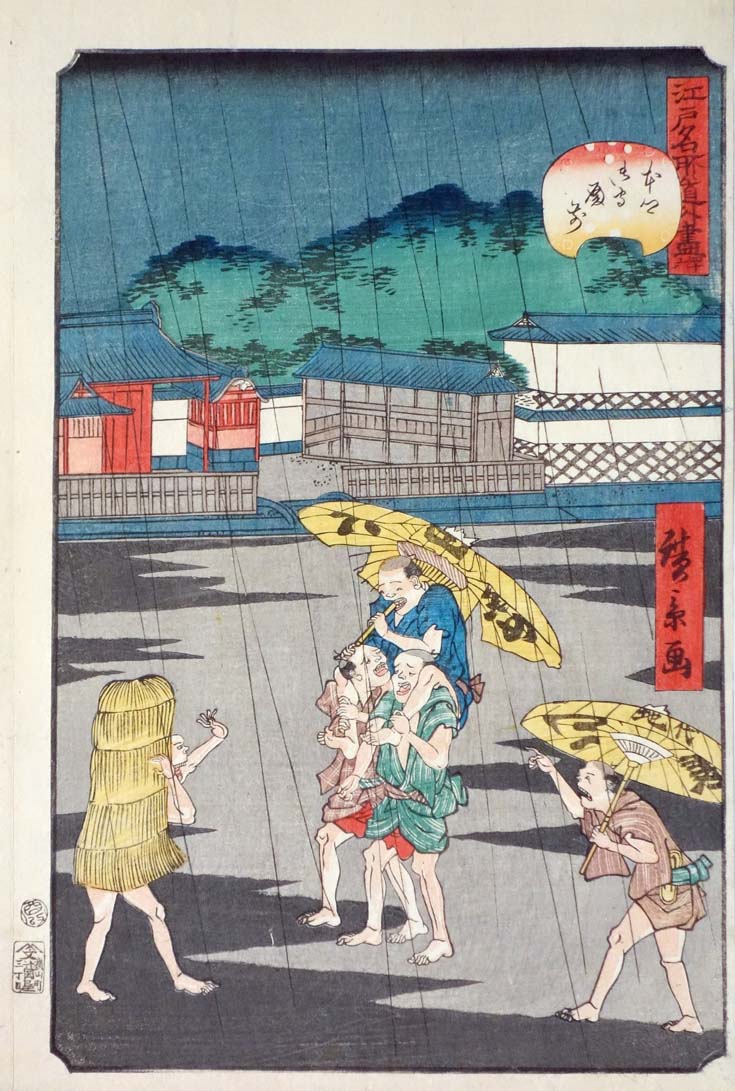
Utagawa Hirokage “Comical Views of Famous Places in Edo : No. 46, In Front of Goshuden Gate in Hongō” (Ota Memorial Museum of Art) A sudden shower. This is the solution for three men who only had one
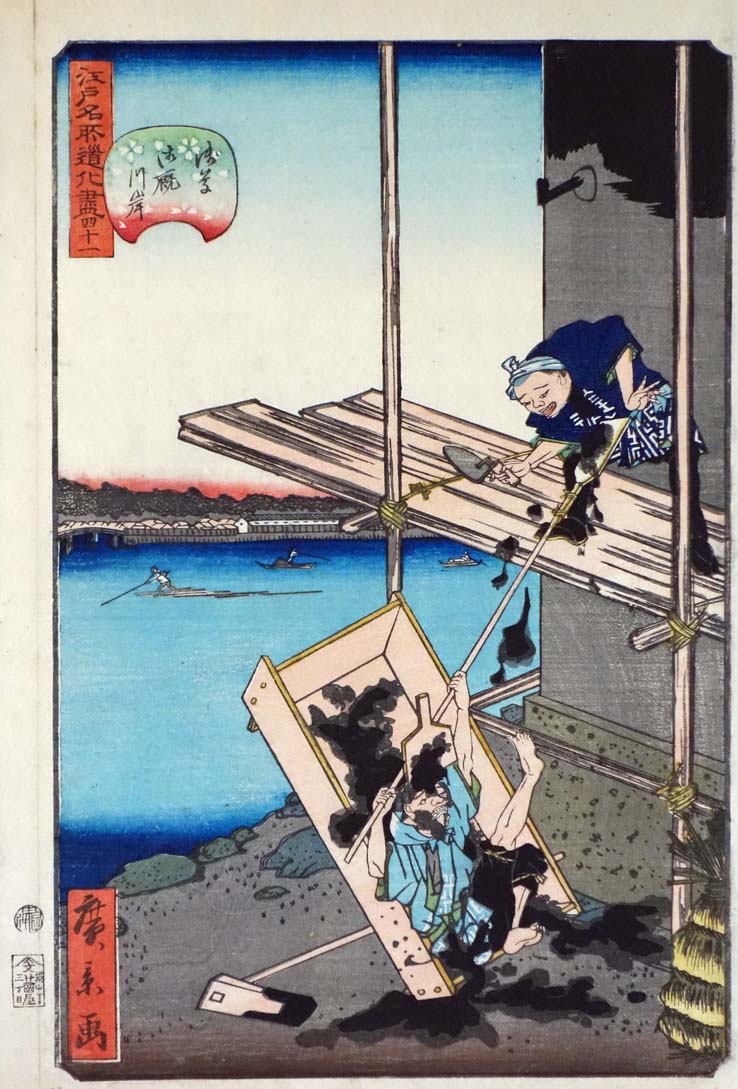
Utagawa Hirokage “Comical Views of Famous Places in Edo : No. 41, Onmayagashi Embankment in Asakusa ” (Ota Memorial Museum of Art) A plaster board hits a man’s head. He tumbles and falls down straight into a box.
The First Exhibition to Explore the Details of the Mysterious Artist, Utagawa Hirokage
The only clear thing known about Utagawa Hirokage is that he was a pupil of Utagawa Hiroshige, and his true character is shrouded in mystery. In this exhibition, we will not only introduce all 50 pictures of his representative work “Comical Views of Famous Places in Edo”, but also his other works such as “Great Battle of the Vegetables and the Fish” and “Thirty-six Views of Mt.Fuji From the Eastern Capital”, to find out more about this mysterious painter.
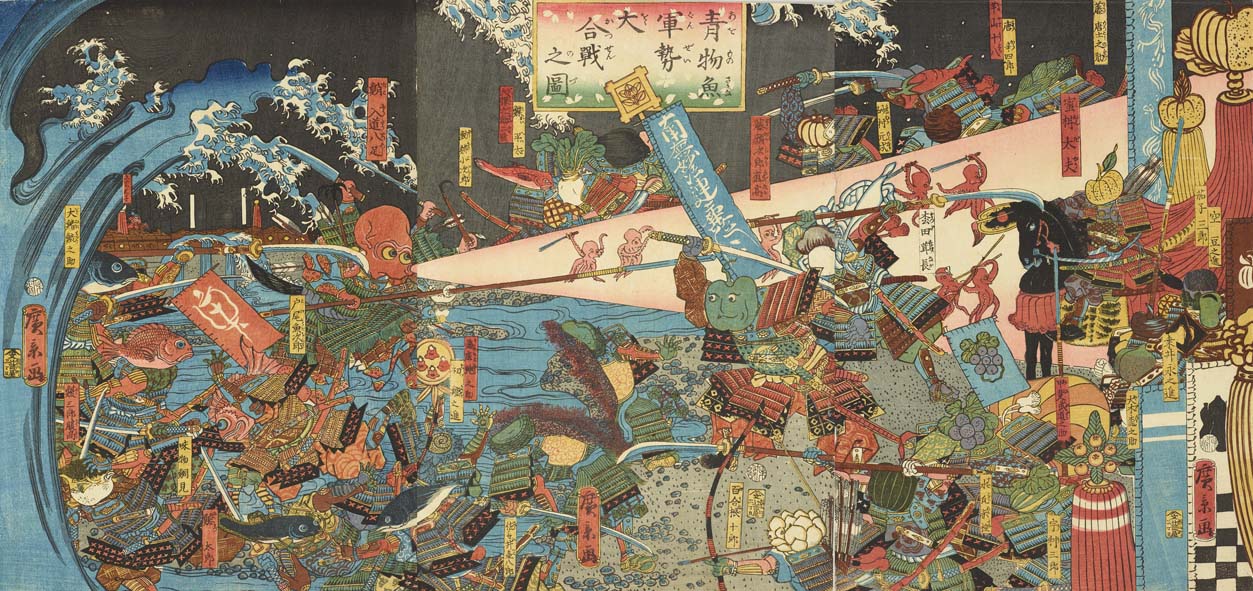
Utagawa Hirokage “Great Battle of Vegetables and Fishes” (Ota Memorial Museum of Art)
Large battle between personified troops of fishes and vegetables.
Copy? Respect? The Strange Relationship between Hokusai and Hiroshige
Several works in the series, “Comical Views of Famous Places in Edo” seem to refer to the works of Katsushika Hokusai and Utagawa Hiroshige. In this exhibition, we will also show the works of Hokusai and Hiroshige, in order to dig into the sources of Hirokage’s ideas and the influences exerted on next generations by his two great predecessors.
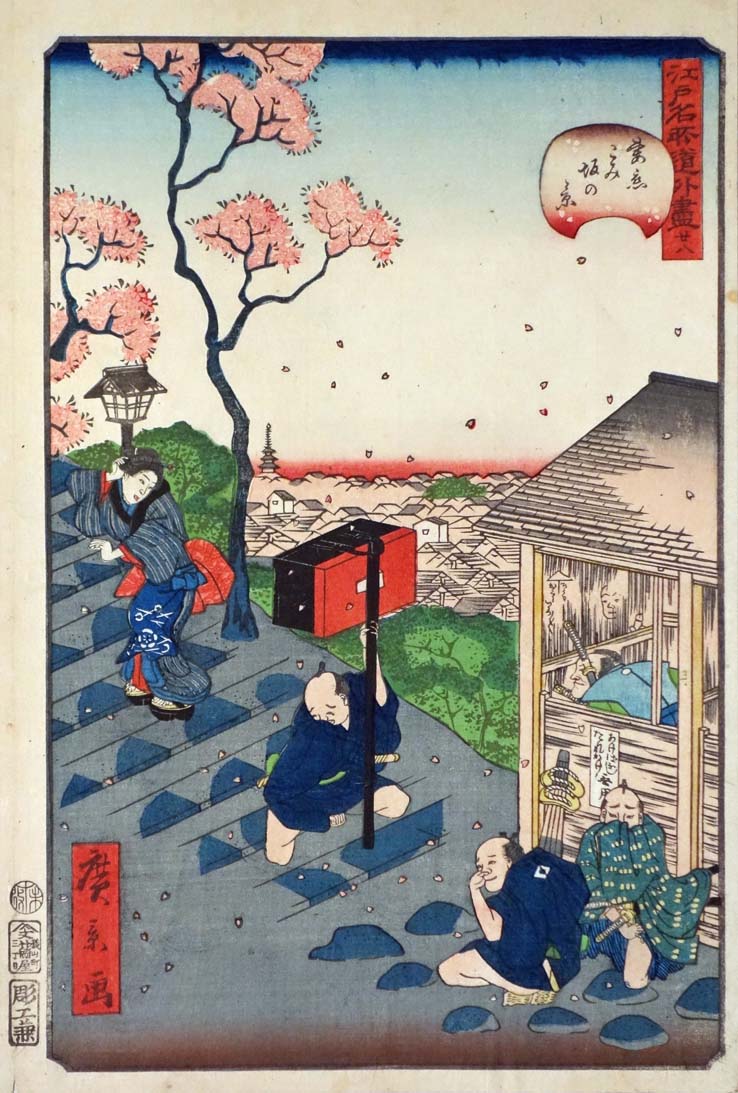
Utagawa Hirokage “Comical Views of Famous Places in Edo : No. 28, View of Gomizaka” (Ota Memorial Museum of Art) Men must pinch their noses to avoid the overpowering smell emitted by a Samurai. Hirokage seems to have entirely copied the work of Hokusai.
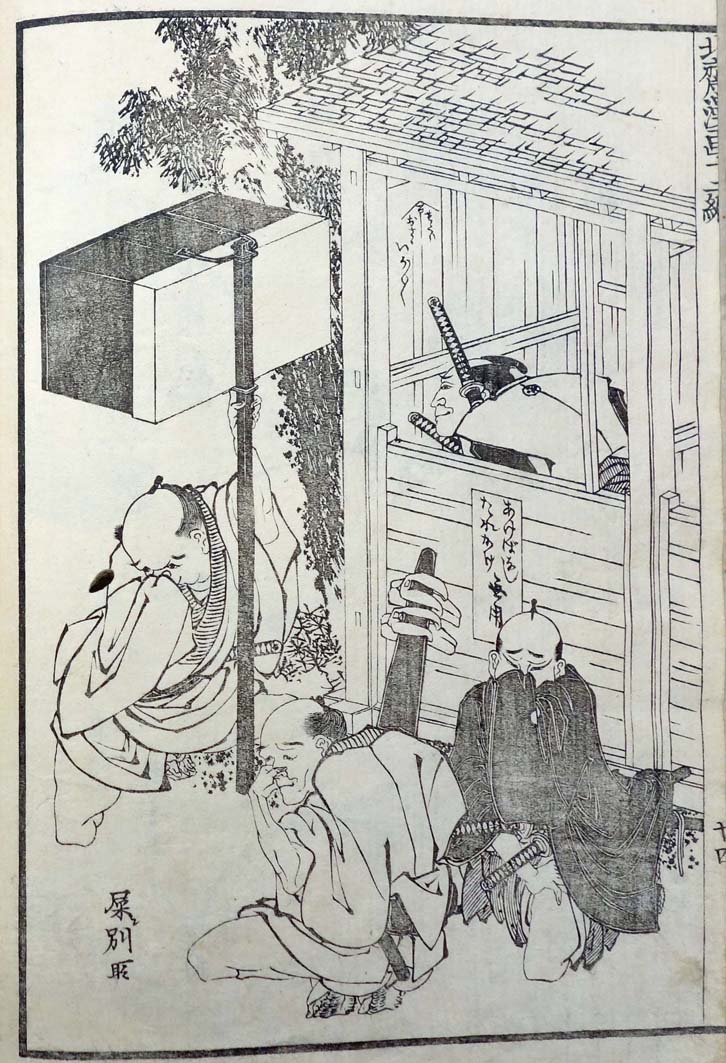
Katsushika Hokusai “Picture Book, “Hokusai Manga”, Volume 12” (Ota Memorial Museum of Art)
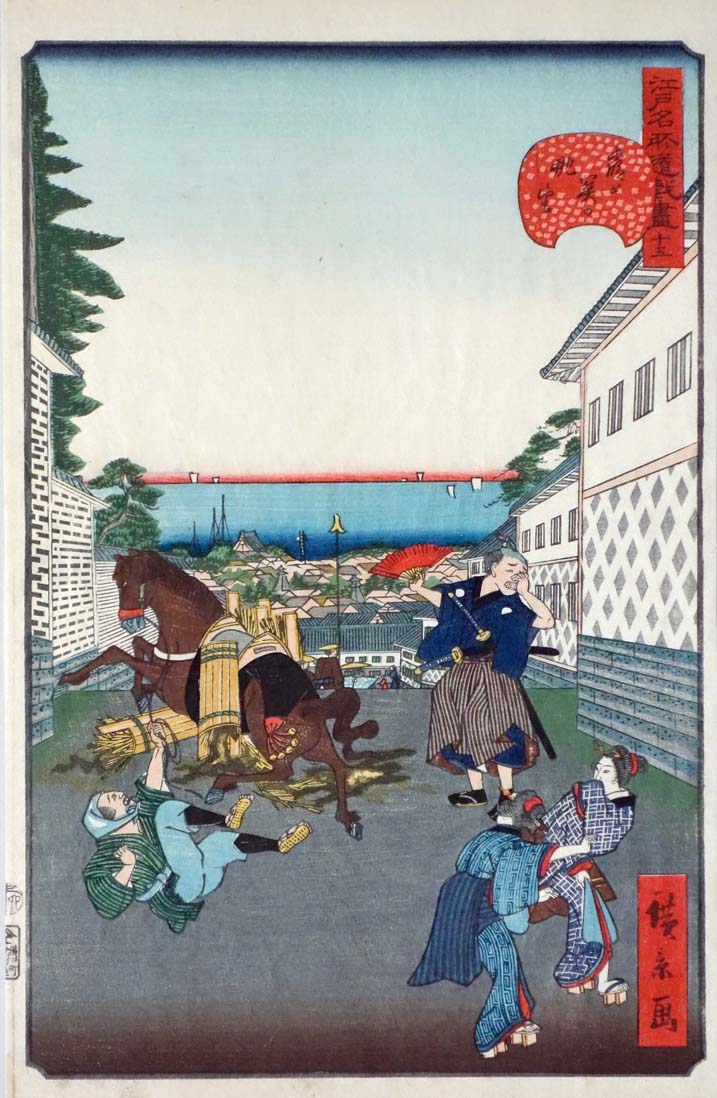
Utagawa Hirokage “Comical Views of Famous Places in Edo : No. 15, Distant View at Kasumigaseki ” (Ota Memorial Museum of Art) A unique composition portraying the Edo Bay from a hilltop, using a perspective method. Hirokage seems to have copied the composition of Hiroshige’s work.
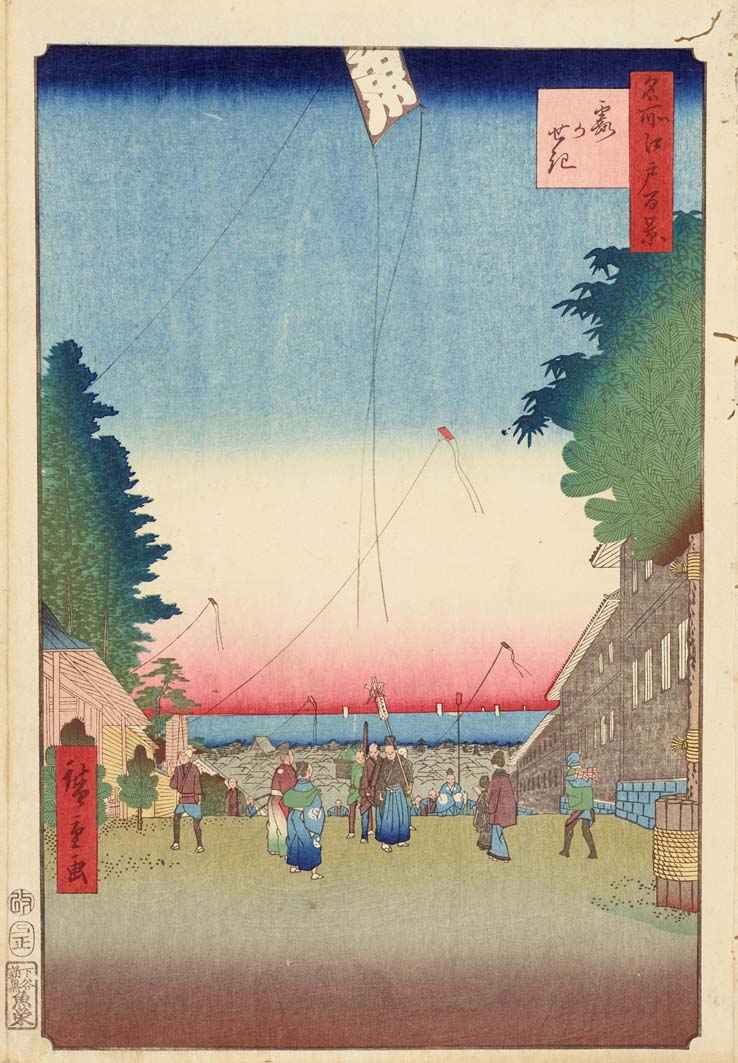
Utagawa Hiroshige “One Hundred Famous Views of Edo : Kasumigaseki”(Ota Memorial Museum of Art)
<Highlight Work of Exhibition>
Utagawa Hirokage “Comical Views of Famous Places in Edo : No. 16, Fox-fires at Ōji ” (Ota Memorial Museum of Art)
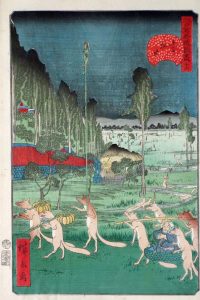
Foxes playing pretend a daimyō’s (feudal lord’s) procession. They are carrying pumpkin instead of travelling bags and holding a bamboo stick with hanging corn instead of a spear. The man sitting in a bamboo basket seems to be delighted, bewitched by the foxes to feel as if he were a feudal lord. The place is near the Ōji Inari Shrine. It was said that foxes gathered to the Shrine on New Year’s Eve, and farmers forecasted the harvest of next year depending on the numbers of foxfires they see.
Translation Supervised by Japanese Students Association of Princeton University
Admission
| Adult | 700 yen |
|---|---|
| University and High school students | 500 yen |
| Junior High School Students and below | Free |
Calendar
Closed
- 2017, January
SUN MON TUE WED THU FRI SAT 1 2 3 4 5 6 7 8 9 10 11 12 13 14 15 16 17 18 19 20 21 22 23 24 25 26 27 28 29 30 31
Mizuno Toshikata~Successor of Yoshitoshi
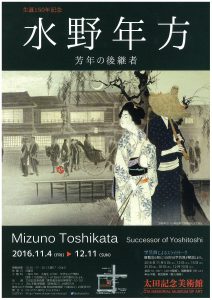
2016, November 4th ~December 11th
(will be closed on November 7, 14, 21, 28th / December 5th)
The First Exhibition to Explore the Whole Picture of Ukiyo-e Artist of Meiji, Mizuno Toshikata
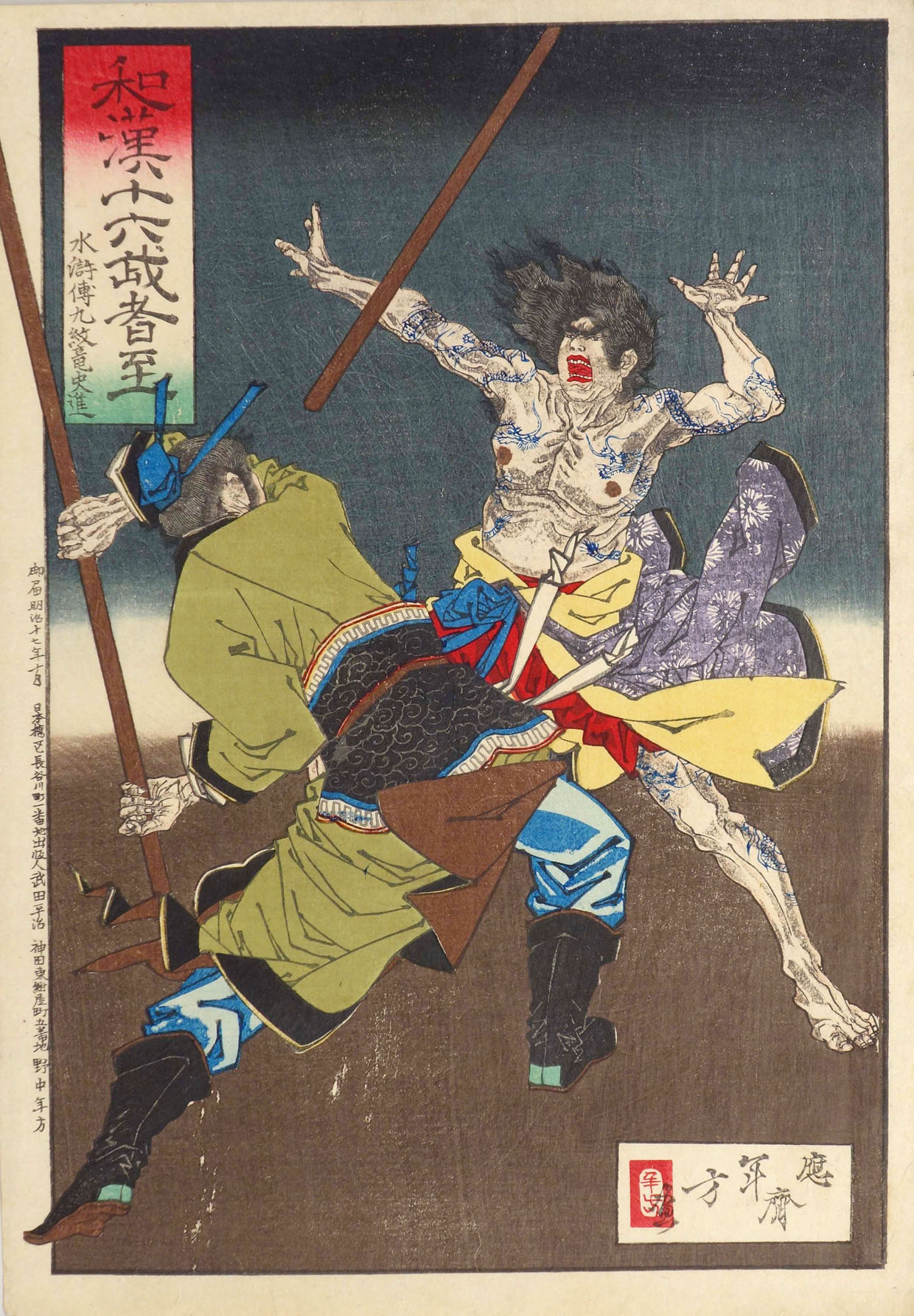
Mizuno Toshikata “Heroes from Tales of the Water Margin : Kumonryū Shishin” 1884 (Ōta Memorial Museum of Art)
Mizuno Toshikata (1866~1908) was an ukiyo-e artist and Japanese-style painter of the Meiji period. He apprenticed under Tsukioka Yoshitoshi, and succeeding his master’s style of painting, worked on historical paintings, bijin-ga (portraits of beautiful women), newspaper illustrations, and war picture depicting the Sino-Japanese war. Furthermore, his frontispiece drawings for novels and for literary magazines such as the “Bungei Club” gained much popularity.
Moreover, Toshikata became an associate member of the Japan Art Academy, led by Okakura Tenshin , and discussed with fellow painters such as Yokoyama Taikan and Hishida Shunsō about producing a new style of Japanese painting. Considering that his line of pupils include Ito Shinsui, it can be said that Toshikata had a considerable impact on Japanese-style paintings of the Taishō and Shōwa periods.
However, Toshikata has received little attention not only in the context of modern art history but also within ukiyo-e history. Perhaps his early death at the age of 43 is a reason.
This year celebrates the 150th anniversary of the birth of Mizuno Toshikata in 1866. In commemoration, this exhibition displays his works, with a focus on ukiyo-e wood-block prints. This is the first exhibition to explore the works of Mizuno Toshikata as an ukiyo-e artist. Please enjoy the tender colors, rarely achieved in such wood-block prints, and the sweet beauty of the women of the Meiji period.
Successor of Tsukioka Yoshitoshi ~Mizuno Toshikata
Mizuno Toshikata became a disciple of Tsukioka Yoshitoshi in his late teenage years, and learned various ukiyo-e such as musha-ga (warrior pictures), historical pictures, and bijin-ga (portraits of beautiful women). His ability and popularity stood out even among senior disciples. After the death of Yoshitoshi, he was even rumored to succeed his master as Yoshitoshi II.
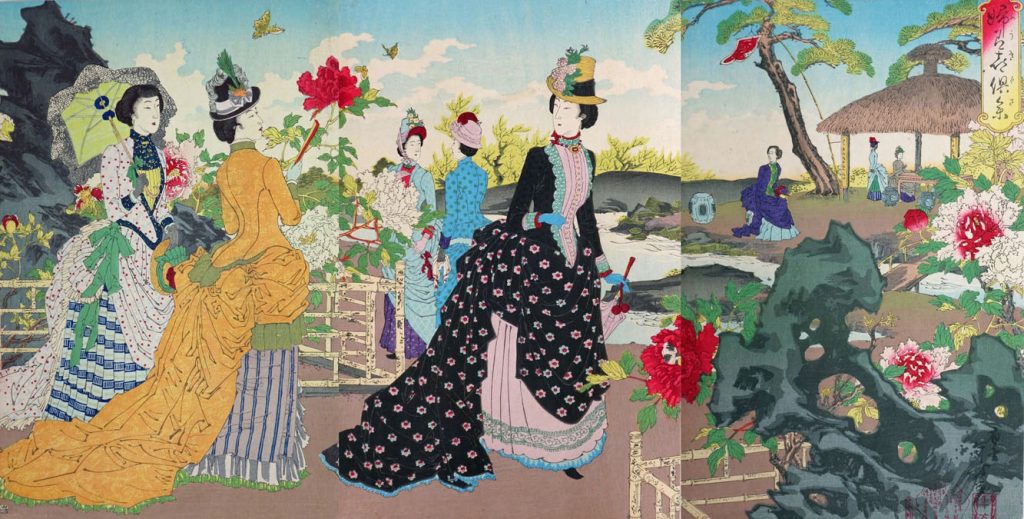
Mizuno Toshikata “Elegant Women in Peony Garden” 1888 (Ōta Memorial Museum of Art)
Izumi Kyōka, Kōda Rohan ~Collaboration with Modern Novelists
Mizuno Toshikata took on frontispiece drawings for literary magazines and novels. Such novelists include Ozaki Kōyō, Izumi Kyōka, Kōda Rohan, and many other representative writers of modern literature. At that time, such frontispiece drawings gained much more popularity than the novel itself. Toshikata played an important role in development of modern literature.
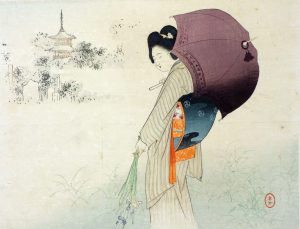
Mizuno Toshikata “Frontispiece Drawing of Novel Titled “Yume Gatari” by Kōda Rohan (“Bungei Club” the 7th Volume, Chapter 11)” 1901 (Ōta Memorial Museum of Art)
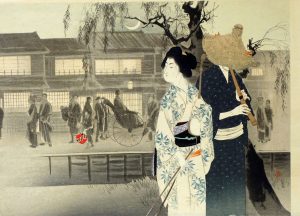
Mizuno Toshikata “Frontispiece Drawing of Novel Titled “Renbo Nagashii” by Oguri Fūyō” 1990 (Ōta Memorial Museum of Art)
Brilliant Beauties of Meiji
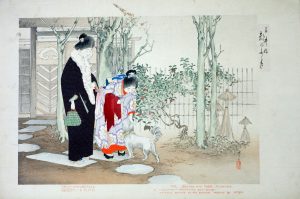
Mizuno Toshikata “Seasons and Their Fashions: Going out in Autumn, a Dog” C.1904 (Ōta Memorial Museum of Art)
Mizuno Toshikata was skilled in depicting glamorous yet dignified women embodying the air of the new Meiji era. Such a female image was succeeded to his disciple, Kaburaki Kiyokata who pioneered the world of bijin-ga during the Taishō and Shōwa periods.

Mizuno Toshikata “Thirty-six Selected Beauties : After the Bath, Woman of the Kansei era (1789-1801),” 1892, (Ōta Memorial Museum of Art)
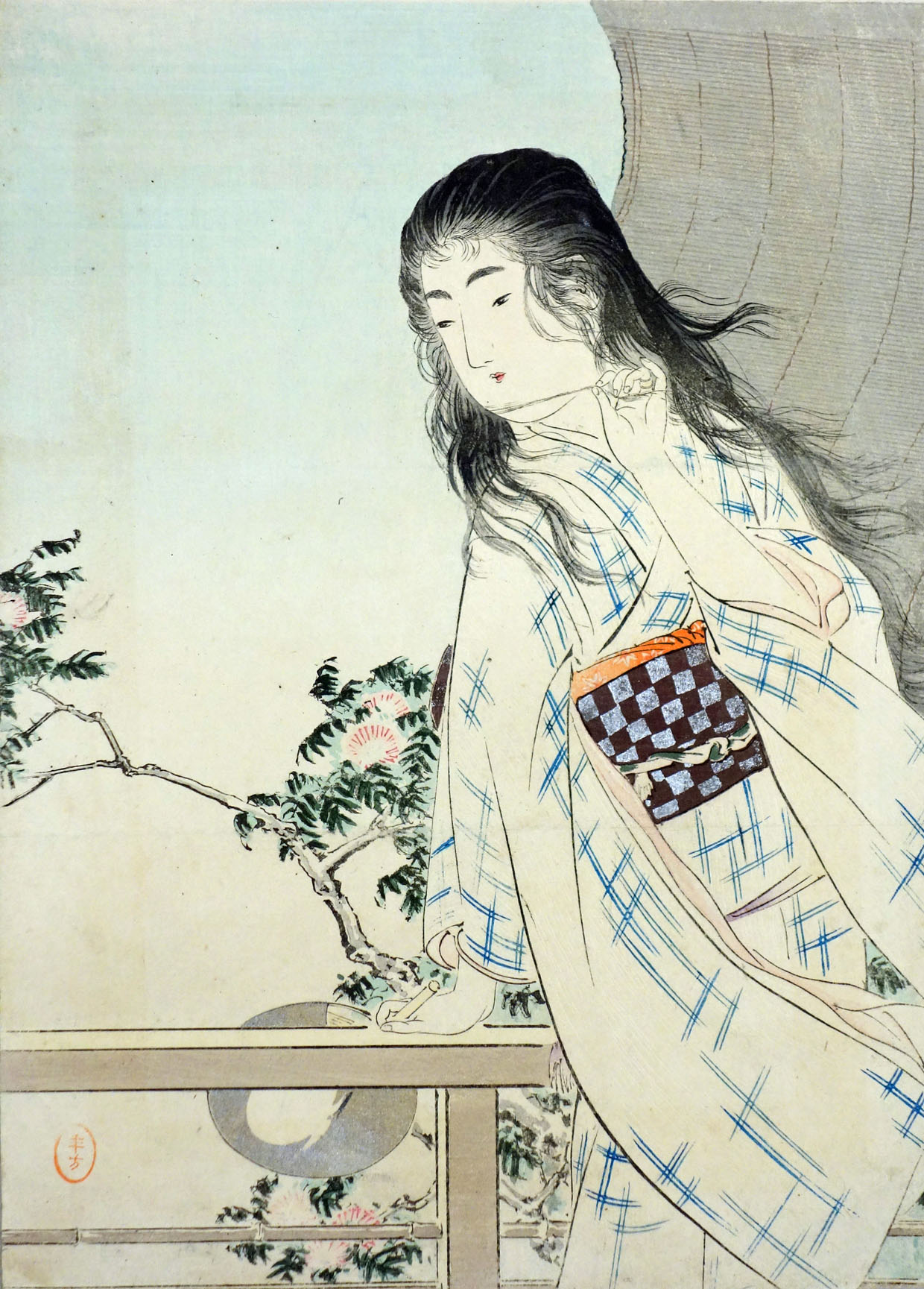
Mizuno Toshikata “Frontispiece Drawing (“Bungei Club” the 12th Volume, Chapter 11) : Woman Standing in front of Bamboo Blind” 1906 (Ōta Memorial Museum of Art)
Highlight Work of the Exhibition
Mizuno Toshikata “Frontispiece Drawing of Novel Titled “Gekashitsu (operation room)” by Izumi Kyōka (“Bungei Club” the 1st Volume, Chapter 6 ) “ 1895 (Ōta Memorial Museum of Art)
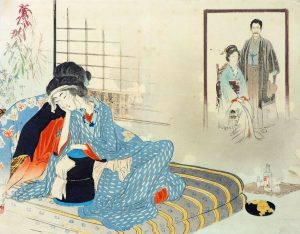
“Gekashitsu (operation room)” is a representative novel from the early works of Izumi Kyōka. Though this novel was published in a literary magazine titled “Bungei Club”, Mizuno Toshikata drew the frontispiece for this novel. At that time, such frontispieces were created by wood-block prints, and therefore were time consuming. Toshikata needed to complete the picture of frontispiece without satisfactory understanding about the novel’s content. Although “Gekashitsu” takes place in an operation room, Toshikata’s frontispiece shows a woman recuperating at home. It seems that the frontispiece does not associate well with the novel. Nevertheless, readers of the time were mesmerized by Toshikata’s finely detailed frontispiece.
Translation Supervised by Japanese Students Association of Princeton University
Admission
| Adult | 700 yen |
|---|---|
| University and High school students | 500 yen |
| Junior High School Students and below | Free |
Calendar
Closed
- November
SUN MON TUE WED THU FRI SAT 1 2 3 4 5 6 7 8 9 10 11 12 13 14 15 16 17 18 19 20 21 22 23 24 25 26 27 28 29 30 - December
SUN MON TUE WED THU FRI SAT 1 2 3 4 5 6 7 8 9 10 11 12 13 14 15 16 17 18 19 20 21 22 23 24 25 26 27 28 29 30 31
Kuniyoshi Heroes~Heroes from Tales of the Water Margin
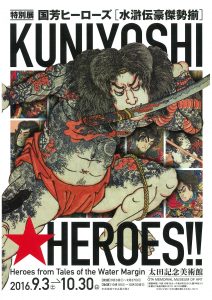
2016, September 3rd~October 30th
【1st Term】 2016, September 3rd ~27th
【2nd Term】 2016, October 1st ~30th
Works change between two terms
(Will be closed on September 5,12,20, 26,28~30 / October 3,11,17,24th)
This is Kuniyoshi! The world of Tales of the Water Margin with tingling blood with excitement
In 1797, Kuniyoshi was born in Nihonbashi Honshiroganechō-1 chōme in a household that worked in the textile dyeing industry. He became the pupil of Utagawa ToyokuniⅠwhen he was about 12 years old and started using the pseudonym, Kuniyoshi, in around 1813. In his twenties, he produced illustrations for Gokan(type of picture book popular in the late Edo period). Among those were portraits of kabuki actors, warrior picture, and others, but the number of works are not many. For a long period of time, Kuniyoshi could not excel among the various pupils of ToyokuniⅠ.However, this changes in 1827, when he published the series titled “One Hundred and Eight Heroes from Tales of the Water Margin”, based on the well-known Chinese novel, “Tales of the Water Margin”.
Kuniyoshi depicted the powerful and exotic foreign heroes with a dynamic brushstroke and the warrior pictures quickly gained popularity. This popularity was such that people started to want tattoos with these warriors as well. With this, Kuniyoshi joins the group of popular artists and establishes his status as “Kuniyoshi of Warrior Pictures”. At the same time, he created masterpieces from various genres such as caricatures, landscape pictures, pictures of beautiful women, and others later, becoming one of the representative ukiyo-e artists of the time.
In this exhibition, we will exhibit almost all Kuniyoshi’s works from this popular series in addition to the various other pictures related to “Tales of the Water Margin. Please enjoy the figures of brave heroes that Kuniyoshi threw his whole soul into.
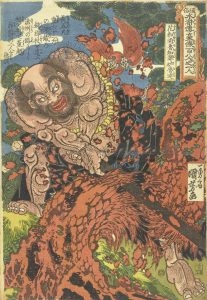
“One Hundred and Eight Heroes from Tales of the Water Margin: Kaoshō Rochishin” (exhibited in the 1st term)
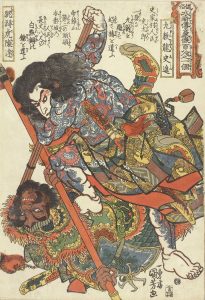
“One Hundred and Eight Heroes from Tales of the Water Margin: Kumonryū Shishin” (exhibited in the 1st term)
Approaching Kuniyoshi’s Starting Point
Brave warriors that defeat the enemies, strategists with an intellectual appearance, heroine wearing splendid clothes- These individualistic and attractive characters appear in Kuniyoshi’s work, “One Hundred and Eight Heroes from Tales of the Water Margin” (No.1~80), also being one of his first works. The people of Edo were excited to see the unyielding fighting spirit, friendship and dramatic fate of these various warriors. Kuniyoshi started to produce this series from around 1827, and published about more than 70 pieces of pictures across the years. Such a big series with many pieces of pictures didn’t exist before, and this series gained much popularity at that time. The highlight of this series is the figures of brave warriors full of lively movements, description of minute details supported by exquisite technique of carving and printing, designs full of exoticism, and a wide variety of individual brave warriors, and others. In this section of the exhibition, we will introduce its world view by introducing 73 pieces of prints of masterpieces from this series which is considered to be 74 pieces of prints in total.
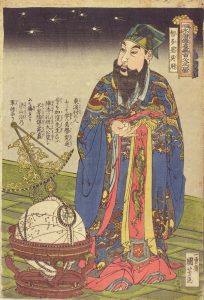
“One Hundred and Eight Heroes from Tales of the Water Margin: Chitasei Goyō” (exhibited in the 2nd term)
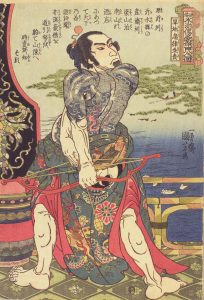
“One Hundred and Eight Heroes from Tales of the Water Margin: Kanchikotsuritsu Shuki” (exhibited in the 2nd term)
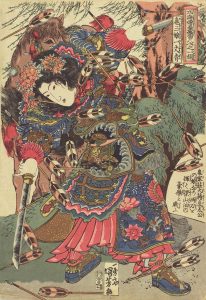
“One Hundred and Eight Heroes from Tales of the Water Margin: Kosanjō Ichijōsei” (exhibited in the 1st term)
Full force of various “Tales of Water Margin”
This exhibition exhibits together with such related pictures. Please feel and touch not only the ability of arrangement by Kuniyoshi but also the ambience of the boom of “Tales of Water Margin” at that time.
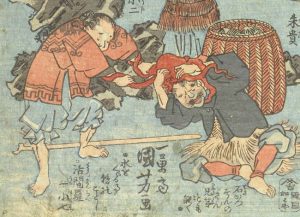
“Caricatures of One Hundred and Eight Heroes of Tales of the Water Margin: Sheet 1 of 10” (private collection / exhibited in the 1st term) This is the parody picture. Genshōgo is the expert of swimming. He is attacked by octopus.
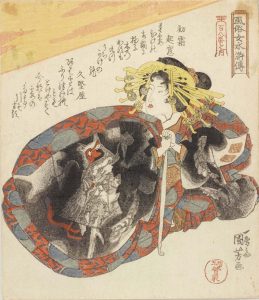
“Elegant Women as One Hundred and Eight Heroes of the Water Margin: Goyō” (private collection / exhibited in the 2nd term) Here a high-ranking courtesan wears kimono with the motif of Kumonryū Shishin.
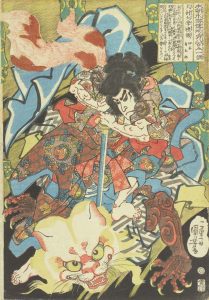
“One of the Eight Hundred Heroes of the Water Margin of Japan: Inumura Daikaku Masanori” (private collection / exhibited in the 1st term)
<Highlight Work of Exhibition>
“One Hundred and Eight Heroes from Tales of the Water Margin: Rōrihakuchō Chōjun”
(Private collection / exhibited in the 2nd term)
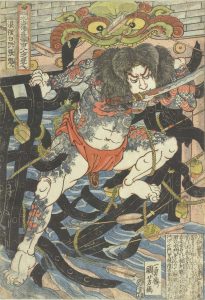
This is the representative picture of this series. A man glares with a sword in his mouth. The bent fence is a water gate. This man is Rōrihakuchō Chōjun and he was a master of swimming, exerting himself as the leader of naval forces. This picture depicts the last scene of the novel. Here, Chōjun breaks the water gate in order to attack the Hangzhou castle. The angry facial expression, strong-muscled body and blue tattoo on his white skin show his wild strength. After he broke the water gate, he died from a group attack by the enemy and could not come back to his friends till the end. Kuniyoshi depicts the appearance of a courageous hero whose death is approaching.
Translation Supervised by Japanese Students Association of Princeton University
Admission
| Adult | 1000 yen |
|---|---|
| University and High school students | 700 yen |
| Junior High School Students and below | Free |
Calendar
Closed
-
- September
SUN MON TUE WED THU FRI SAT 1 2 3 4 5 6 7 8 9 10 11 12 13 14 15 16 17 18 19 20 21 22 23 24 25 26 27 28 29 30 - October
SUN MON TUE WED THU FRI SAT 1 2 3 4 5 6 7 8 9 10 11 12 13 14 15 16 17 18 19 20 21 22 23 24 25 26 27 28 29 30 31
-
Scary Pictures of Ukiyo-e
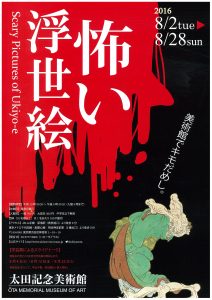
2016, August 2nd ~28th
(will be closed on August 8, 15, 22nd)
Test of Courage at the Museum
“Scary”, “Horrifying” – fear is a universal feeling that people have. People hate and avoid those that are unknown, dangerous, and weird. However, as is evident in the word “Curiosity overcomes fear” fear also brings strong feelings of curiosity. At times, even fear close to danger can be a thrilling excitement for people. Perhaps it is this “Curiosity overcomes fear” that create the popularity of horror and suspense.
People of the Edo were also very interested in scary, horrifying things. Ghost stories were popular as represented in the Kabuki play, “Tōkaidō Yotsuya Kaidan” by Tsuruya Nanboku IV. There were also many Ukiyo-e depicting ghosts and horrifying bloody scenes. At this exhibition, we will look at horror of the Edo from Ukiyo-e. There are ghosts full of grudge from their lifetime such as Kasane, Oiwa, and Sutoku-in, as well as ogres, sea monsters, demon spiders, other weird-looking creatures and pictures full of blood. We hope you enjoy the variety of fear with a pleasant chill.
1, Ghosts
Ghosts are departed souls wandering in the world after death. In the late Edo period, ghost and monster themed novels and kabuki plays became popular, and many kinds of ghosts were depicted in ukiyo-e wood-block prints. In this section, we will introduce the figures of horrible ghosts such as Kasane, Oiwa, Okiku, Asakura Tōgo and Sutoku-in, and others that died an unnatural death and accomplished revenge with a terrible grudge.
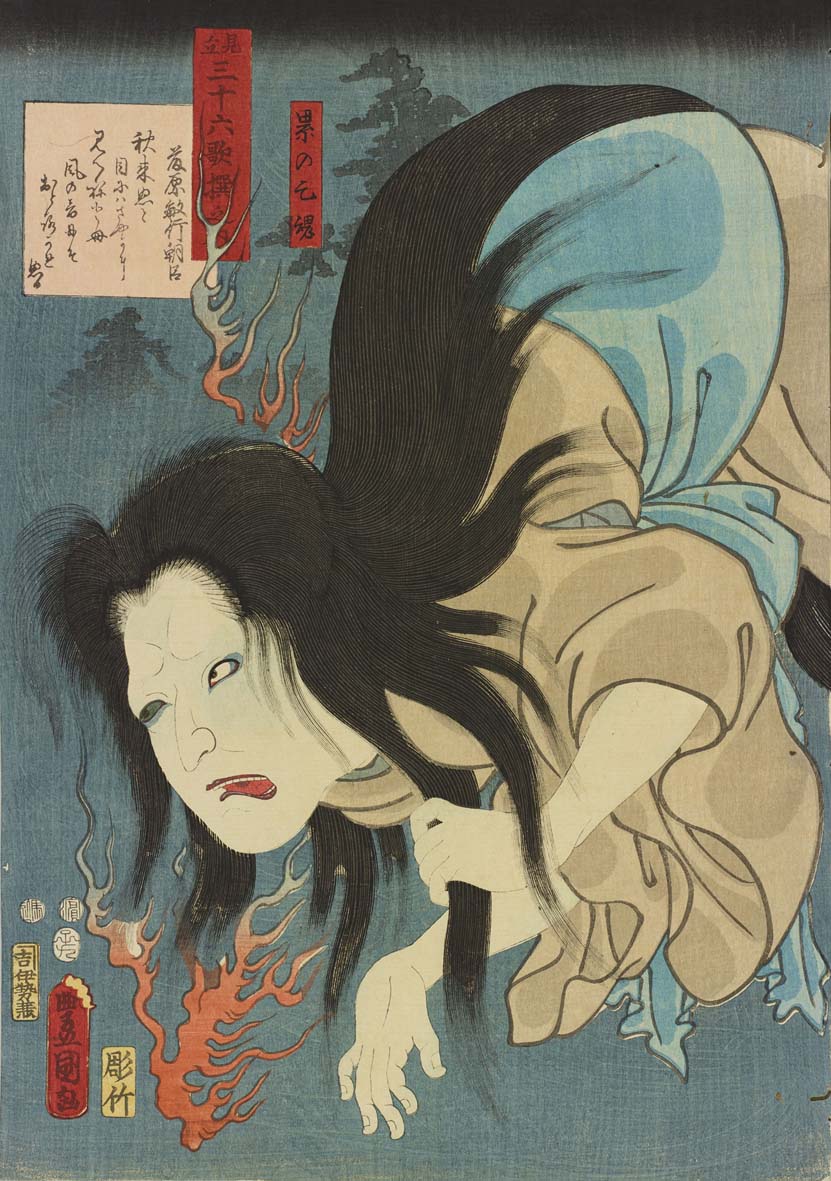
Utagawa Kunisada (ToyokuniⅢ) “Parody of Thirty-six Poems : Ghost of Kasane with the Poem of Fujiwara no Toshiyuki Ason” (Ōta Memorial Museum of Art)
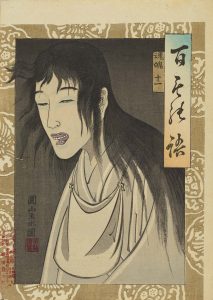
Utagawa Yoshiiku “One Hundred Ghost Stories: Ghost” (Ōta Memorial Museum of Art)
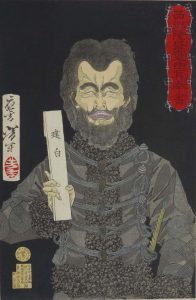
Tsukioka Yoshitoshi “Ghost of Saigō Takamori Holding a Petition” (Ōta Memorial Museum of Art)
2, Specters
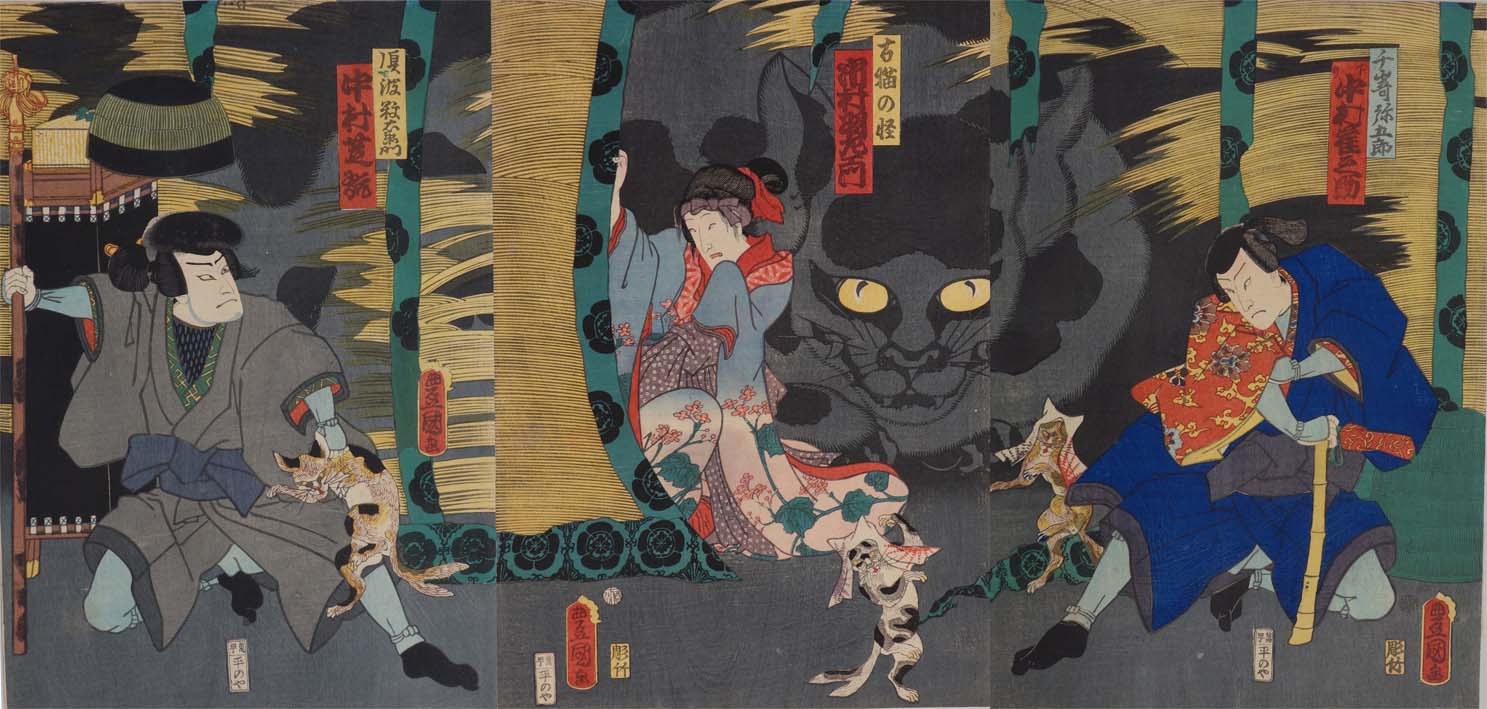
Utagawa Kunisada (ToyokuniⅢ) “Kabuki Play, “Tōkaidō Iroha Nikki”” (Ōta Memorial Museum of Art)
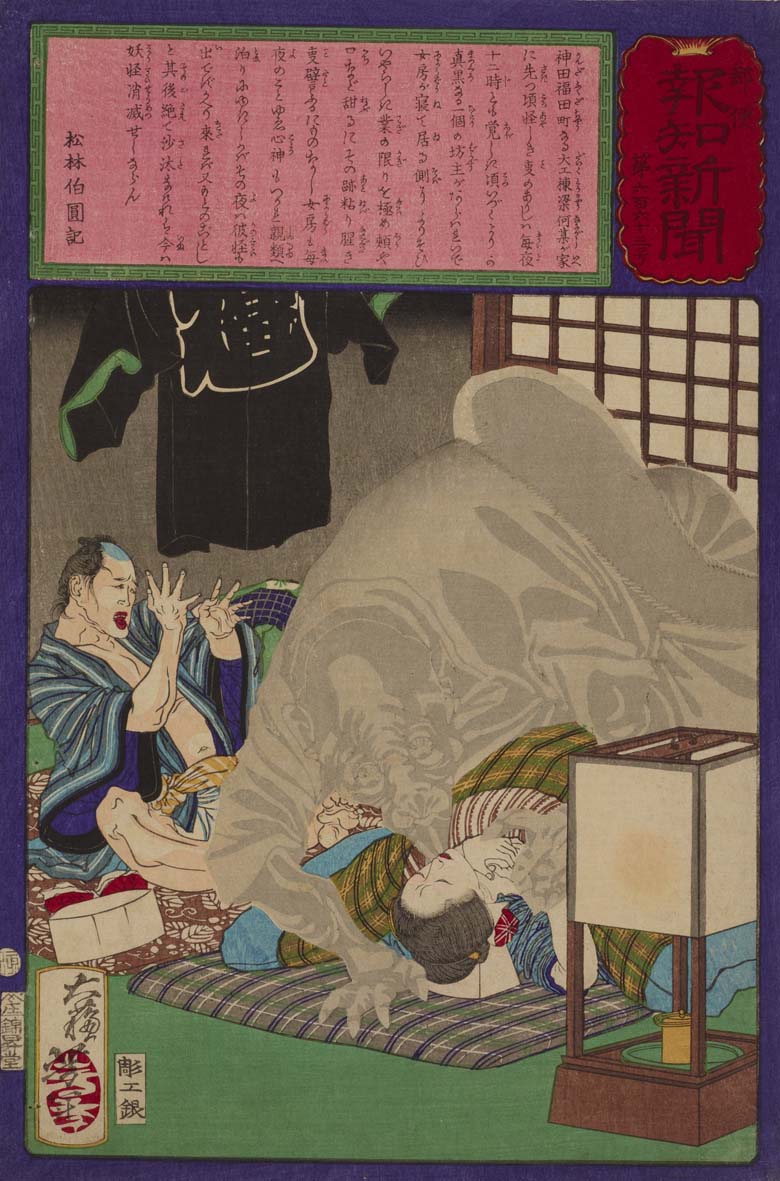
Tsukioka Yoshitoshi “Illustration for a Newspaper called Yūbin Hōchi Sinbun, No.663: Monster Attacking a Woman” (Ōta Memorial Museum of Art)
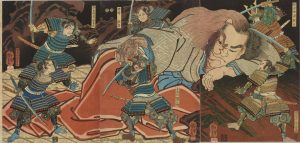
Utagawa Kuniyoshi “Minamoto no Yorimitsu Exterminating Shutendōji of Mt.Ōe-yama “(Ōta Memorial Museum of Art)
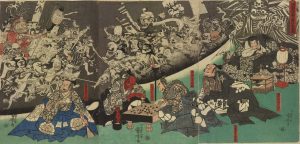
Utagawa Kuniyoshi “Minamoto no Yorimitsu and His Subordinates Attacked by Demon Spider” (Ōta Memorial Museum of Art)
3, Blood-stained Pictures
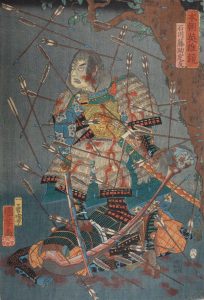
Utagawa Kuniyoshi “Mirror of Our Country’s Heroes:Ishikawa Tōsuke Sadatomo” (Private Collection)
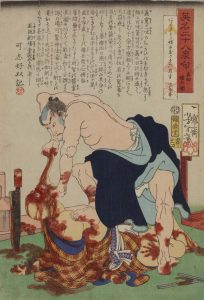
Tsukioka Yoshitoshi “Twenty-eight Famous Murders with Verse: Naosuke Gonbei” (Private Collection)
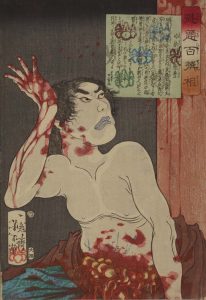
Tsukioka Yoshitoshi “Yoshitoshi’s Selection of One Hundred Warriors : Reisei Hangan Takatoyo” (Private Collection)
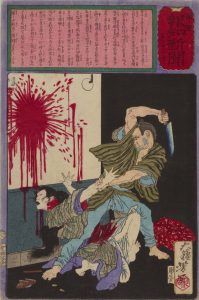
Tsukioka Yoshitoshi “Illustration for a Newspaper called Yūbin Hōchi Sinbun, No.565 : Tajima Seitarō Murdering His Young Wife” (Ōta Memorial Museum of Art)
《Highlight Work of Picture》
Utagawa Kuniyohi “Kabuki Actor, “Ichikawa KodanjiⅣ as Ghost of Oiwa”” (Ōta Memorial Museum of Art)
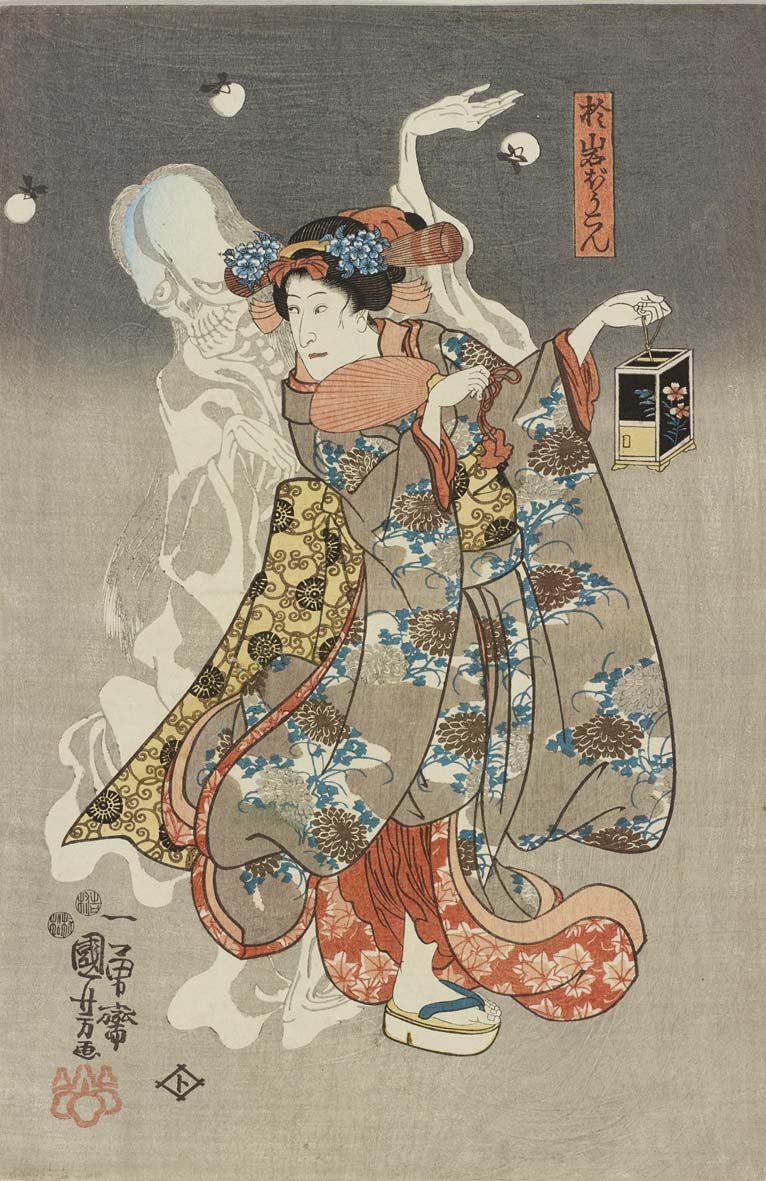
A beautiful young woman, Oiwa is dancing with an insect cage and a round fan in her hands. Fireflies are flying in the black of night. Taking a closer look at this picture, shows the horrible appearance of the ghost of Oiwa dancing behind. The depiction of her appearance is horrible with her hair shed and bone bare. This picture depicts the scene from the kabuki play, “Manetemimasu Yotsuya no Sakigaki” performed in September, 1848 in Ichimura-za Theater. The play borrowed the style from the famous play, “Tōkaidō Yotsuya Kaidan”. This picture depicts the final stage froma the dream scene of the story. The beautiful young woman, Oiwa appears in the dream of main character, Iemon, who committed numerous evil deeds. However, when the beautiful Oiwa drops her mask, she reveals her ghost form, making this scene both beautiful and horrible. Great kabuki actor, Ichikawa DanjūrōⅣ played the role of Oiwa. This picture is a part of a two-pair picture. On the left part of the prints, kabuki actor, Ichikawa Danjūrō I is playing the role of Iemon and Nakamura KantarōⅠis playing the role of Akiyama Chōbei.
Translation Supervised by Japanese Students Association of Princeton University
Admission
| Adult | 700 yen |
|---|---|
| University and High school students | 500 yen |
| Junior High School Students and below | Free |
Calendar
Closed
- August
SUN MON TUE WED THU FRI SAT 1 2 3 4 5 6 7 8 9 10 11 12 13 14 15 16 17 18 19 20 21 22 23 24 25 26 27 28 29 30 31
“Hokusai Manga”~Sketches of the Universe
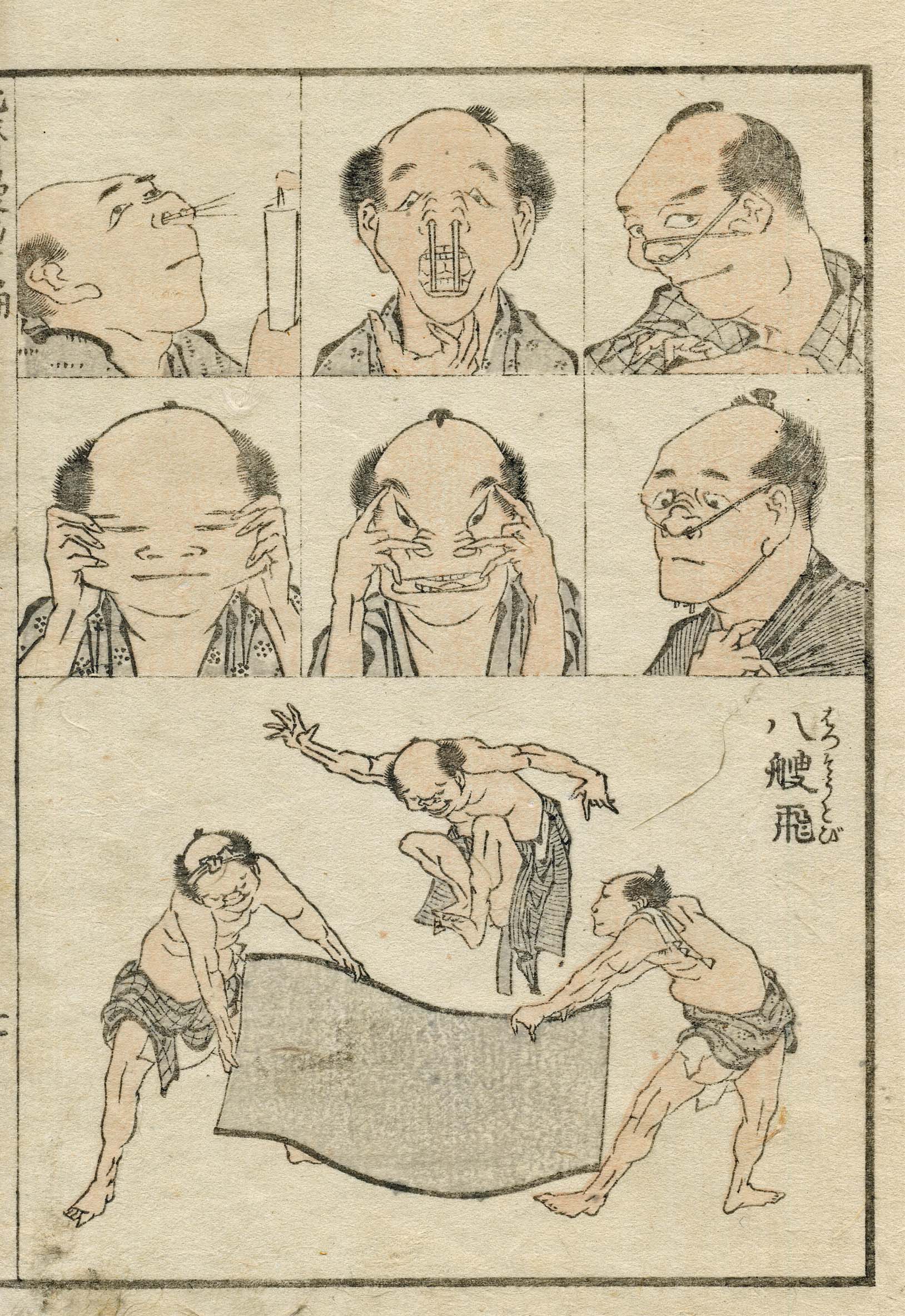
2016, July 1st ~July 28th
(will be closed on July 4, 11, 19, 25th)
Introducing the Lifework of Hokusai
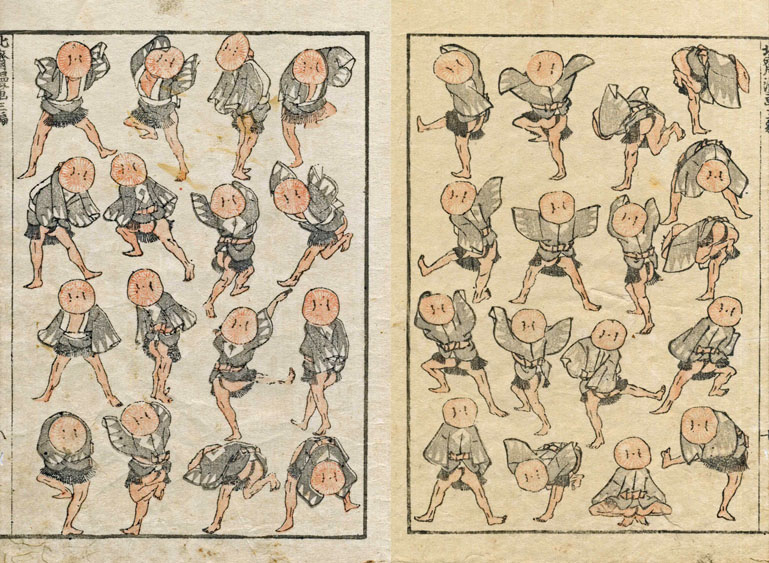
Katsushika Hokusai “Picture Book “Hokusai Manga” Volume 3 “
Hokusai depicted many poses from the dance called Suzume-odori. It seems that we are watching frame-by-frame images of animation.
“Hokusai Manga” is the printed picture book which made Katsushika Hokusai (1760~1849) renown worldwide, along with his landscape series “Thirty-six Views of Mt.Fuji”. The popularity of “Hokusai Manga” didn’t decline ever since the execution of the 1st volume of this printed book in 1814 at when Hokusai was 55. Even years after his death it still remained popular and the series of the printed books was finally completed, having 15 volumes in total, making this piece regarded as Hokusai’s lifework. In this exhibition, we will introduce the charm of “Hokusai Manga”, the book that attempts to depict all the creations of the universe.
Introducing Various Talents of Hokusai by Seven Keywords
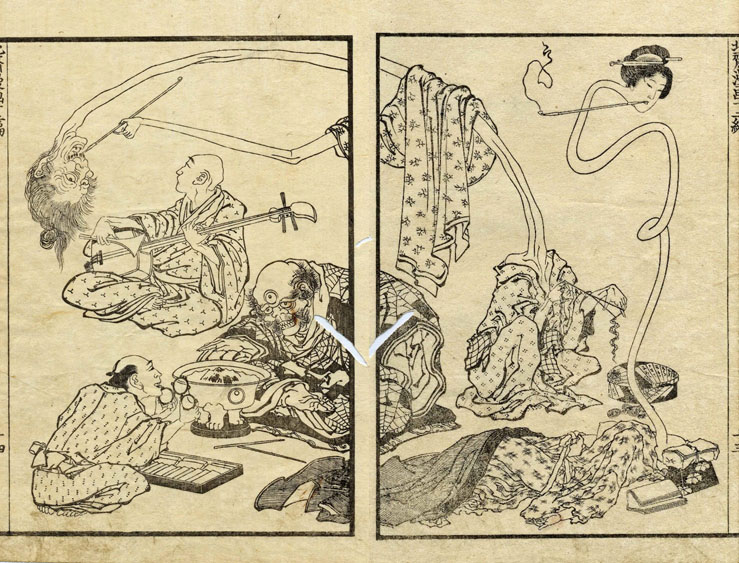
Katsushika Hokusai “Picture Book “Hokusai Manga” Volume 12”
Everyday sceneries of specters such as snoozing and purchasing glasses are depicted.
We will introduce various themes of pictures of “Hokusai Manga” by seven keywords such as saltation, humorousness, livelihood, nature, animal, specter and architecture. We will pay attention to various talents of Hokusai by introducing the works not only Hokusai-like pictures depicting the dynamic movement and humorous figures but also the nature and architecture carefully depicted by the scientist-like gaze which had not been introduced generally.
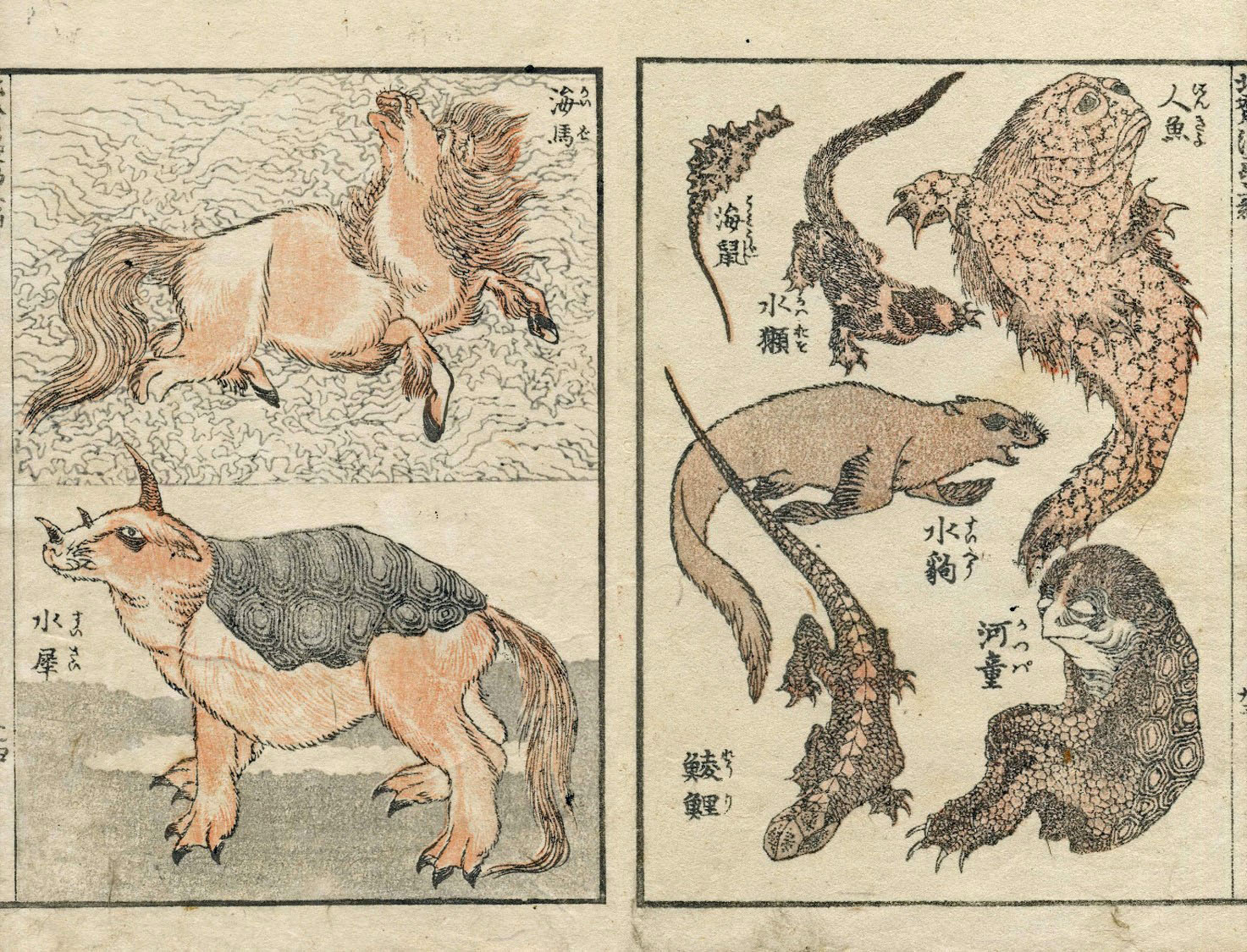
Katsushika Hokusai “Picture Book “Hokusai Manga” Volume 3”
Non-existent creatures such as mermaid, kappa (a mischievous Japanese water sprite) are depicted full of reality.
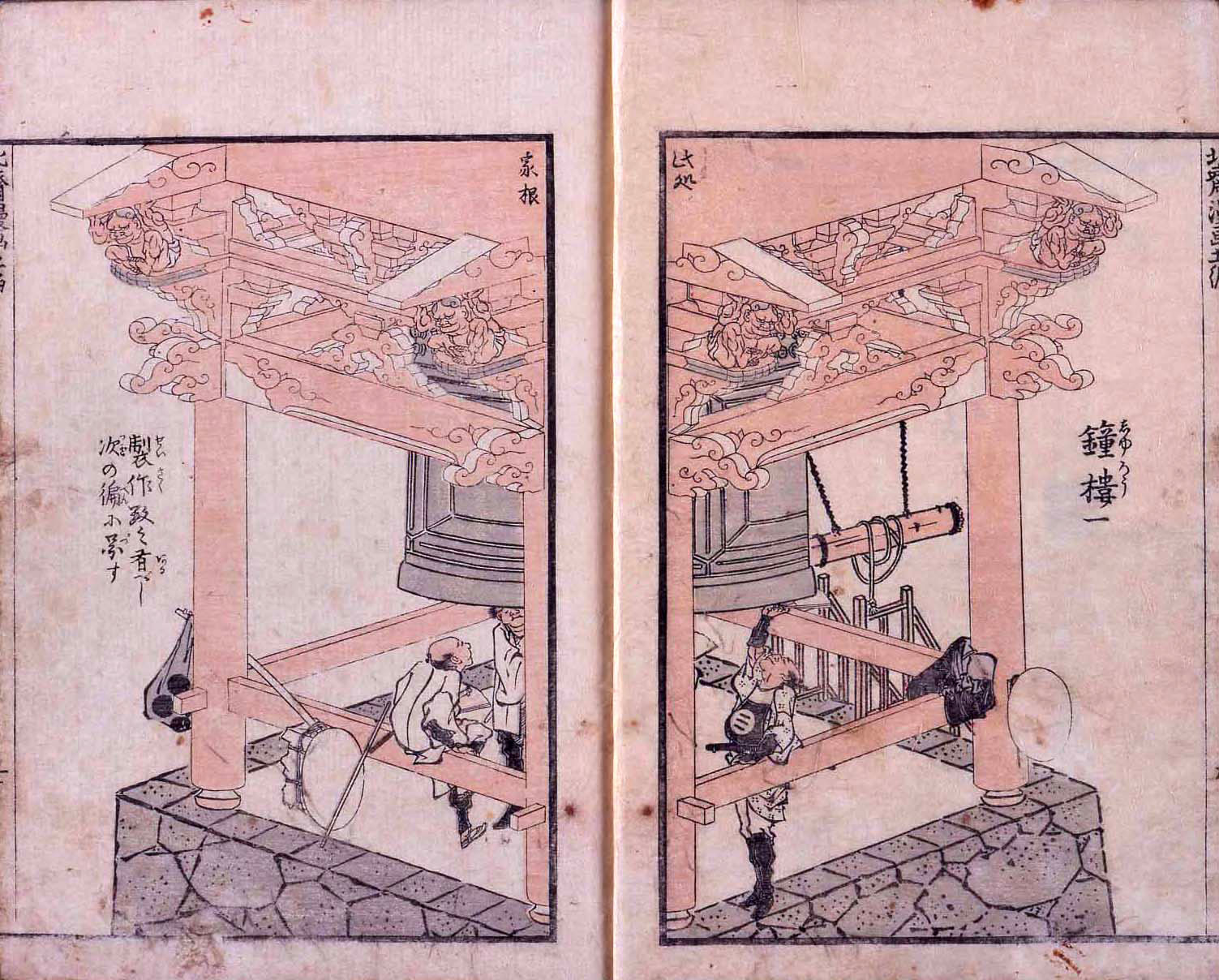
Katsushika Hokusai “Picture Book “Hokusai Manga” Volume 5”
This is totally the plan of the building. Observing the structure of the roof of the bell-tower of temple.
Introducing Wide Range of Picture Books by Hokusai
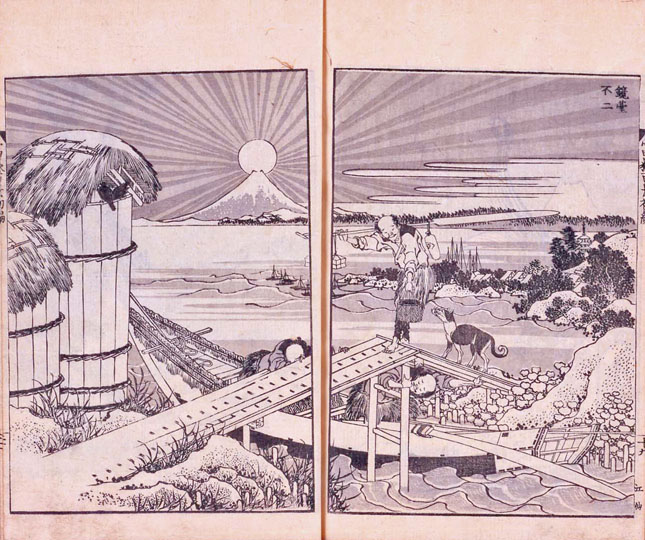
Katsushika Hokusai “Picture Book “Fugaku Hyakkei” Volume 1”
Rising sun is depicted just above the crest of Mt.Fuji. Dazzling morning sunshine shines radially.
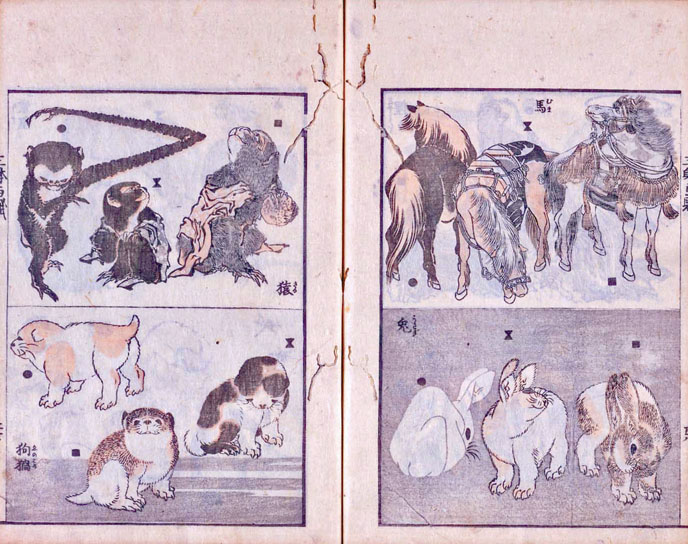
Katsushika Hokusai “Handbook of Illustrations “Santai Gafu“” Horses, rabbits and dogs are depicted differently by three different methods of drawing: “shin-gyō-sō (formal, semi-formal , informal).
<Highlight Work of the Exhibition>
Katsushika Hokusai “Picture Book “Hokusai Manga” Volume 10”
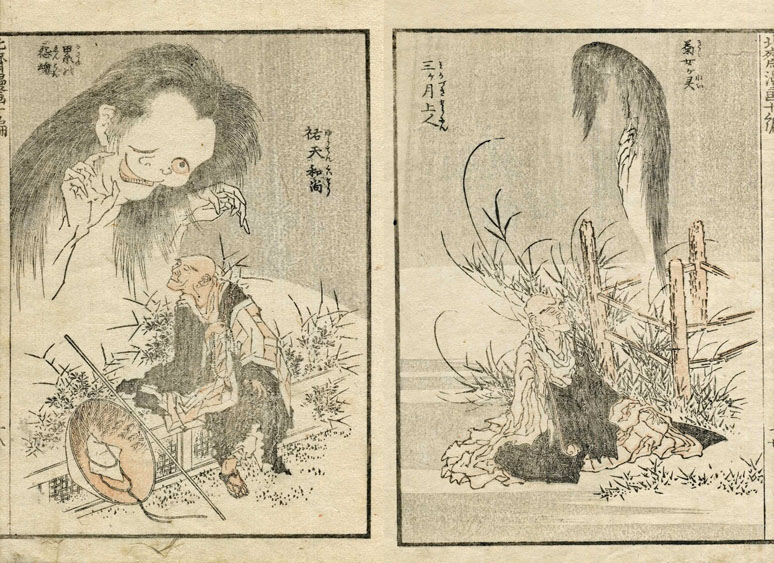
Hokusai illustrated the famous female ghosts Kasane and Okiku, who were popular during the Edo period. On the left is Kasane, who became a ghost after being murdered by her husband. On the right is Okiku, who became a ghost after throwing herself in a well. She had been apprehended for breaking one of her master’s precious plates, and her ghost could be heard counting plates night after night. Kasane and Okiku are depicted with high priests who appeased their spirits.
Translation Supervised by Japanese Students Association of Princeton University
Admission
| Adult | 700 yen |
|---|---|
| University and High school students | 500 yen |
| Junior High School Students and below | Free |
Calendar
Closed
- July
SUN MON TUE WED THU FRI SAT 1 2 3 4 5 6 7 8 9 10 11 12 13 14 15 16 17 18 19 20 21 22 23 24 25 26 27 28 29 30 31
“Utagawa Hiroshige ~Landscapes along the Tōkaidō Road and Mt. Fuji”
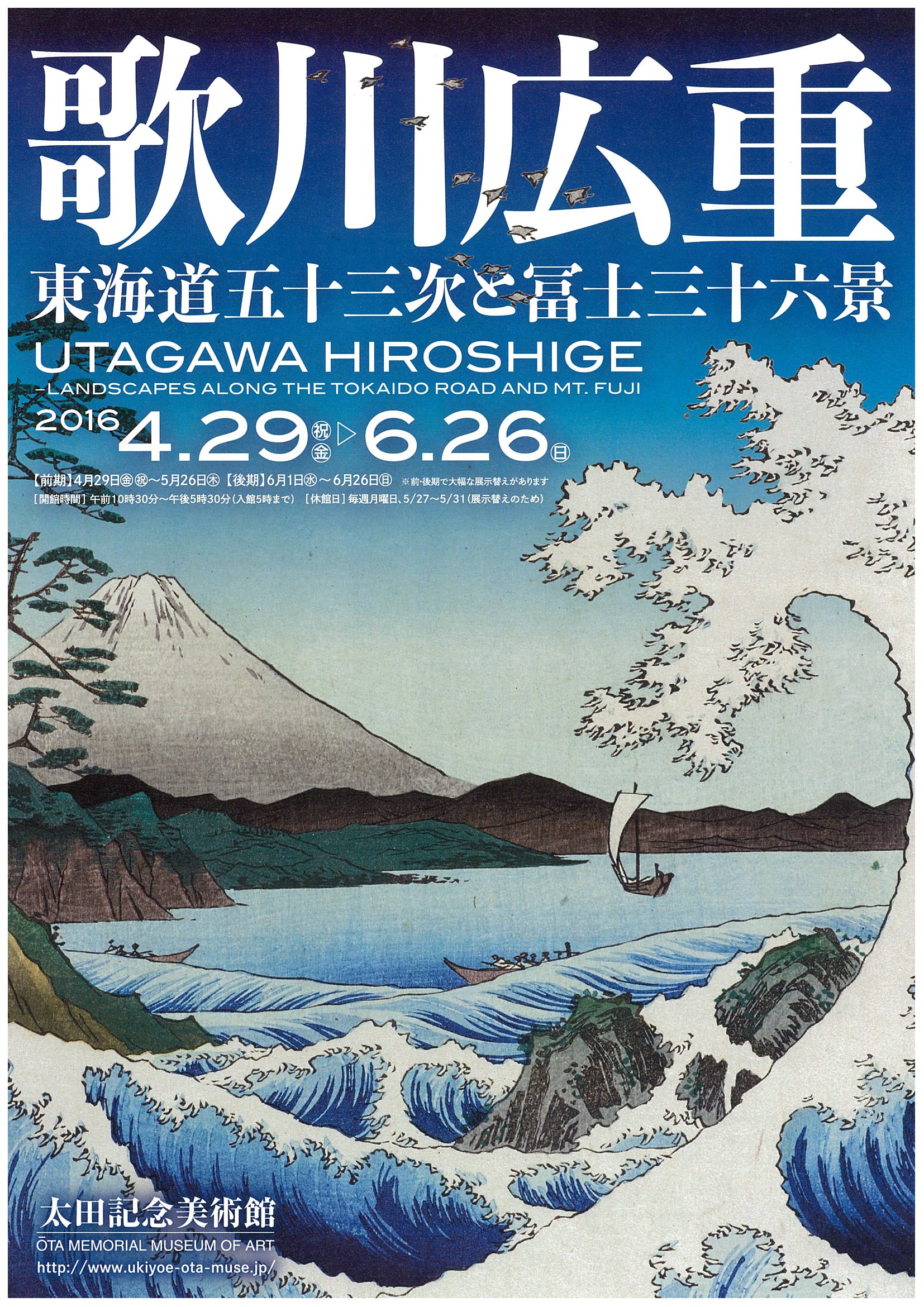
2016, April 29th~June 26th
【1st Term】 April 29th ~May 26th
【2nd Term】 June 1st~26th
(Works change between two terms)
(will be closed on May 2, 9, 16, 23, 27~31st / June 6, 13, 20th)
Breakthrough Series Titled “Fifty-three Stations of the Tōkaidō Road” and Series Titled “Thirty-six Views of Mt.Fuji” in His Later Years- Release of Two Series of Masterpieces by Hiroshige
Utagawa Hiroshige (1797-1858) was one of the leading ukiyo-e artists of the late Edo period, specializing in fūkeiga (landscape pictures). In the 1830s, budding artist Utagawa released his breakthrough series, “Fifty-three Stations of the Tōkaidō”, immediately gaining public attention. This was around the same time Hokusai’s “Thirty-six Views of Mt. Fuji” gained popularity and fukeiga was becoming a trend. Hiroshige’s piece became a big hit and he instantly became a well-known ukiyo-e artist. For the rest of his life, Hiroshige continued to depict Japan’s beautiful sceneries and landscapes in his art. In his later years, he released yet another masterpiece series titled “Thirty-six Views of Mt. Fuji”, a deliberate reference to rival artist Hokusai’s earlier series with the same translated title. This exhibition features the two landmark series mentioned above that highlight Hiroshige‘s ukiyo-e career, as well as his other Tōkaidō-themed works and the series “One Hundred Famous Views of Edo“.
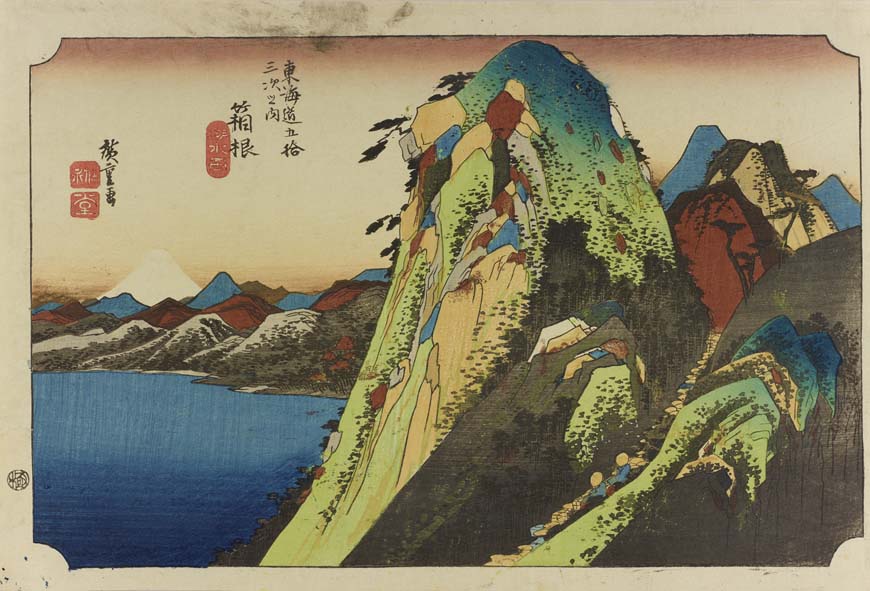
Utagawa Hiroshige “Fifty-three Stations of the Tōkaidō Road: The Lake at Hakone”(Exhibited in the 1st Term of Exhibition)
Hiroshige’s breakthrough: Fifty-three Stations of the Tōkaidō
Hiroshige’s masterpiece, titled “Fifty-three Stations of the Tōkaidō” (Hōeidō edition), is thought to have been created around 1833. Around this time, landscape ukiyo-e woodblock prints increased in popularity, owing to the fame of “Thirty-six Views of Mt.Fuji” by Hokusai. Still a rising artist, Hiroshige released the much anticipated “Fifty-three Stations of the Tōkaidō” following his “Famous Views of the Eastern Capital”, which was created at the beginning of Tempō era (1830~44). “Fifty-three Stations of the Tōkaidō” became very popular and has remained popular to this day. The exhibition features the complete works of this series, as well as alternate versions of the images.
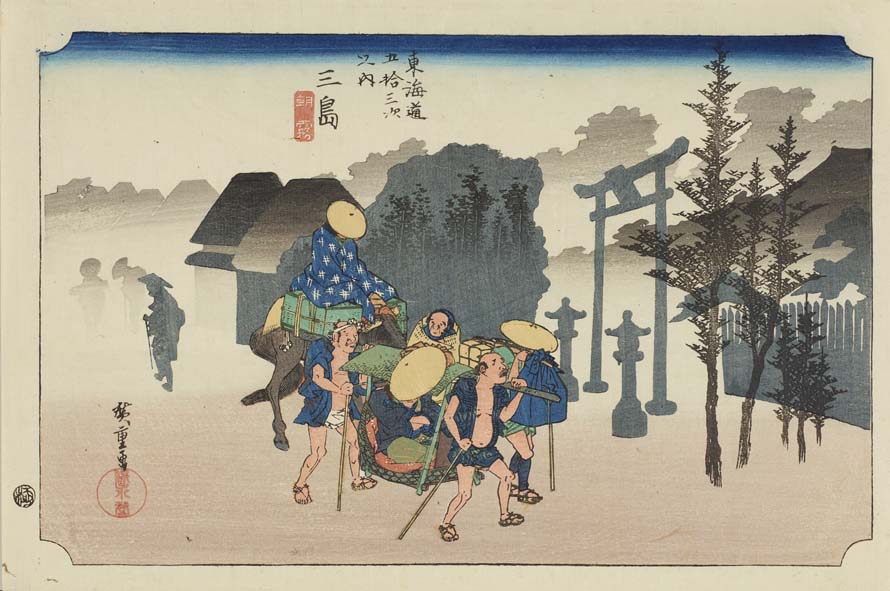
Utagawa Hiroshige “Fifty-three Stations of the Tōkaidō Road: Morning Mist at Mishima” (Exhibited in the 1st Term)
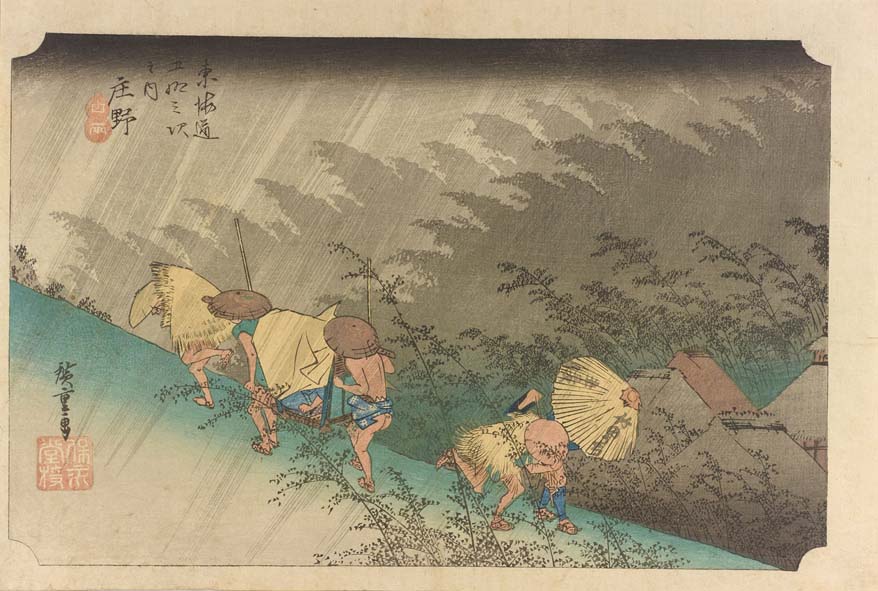
Utagawa Hiroshige “Fifty-three Stations of the Tōkaidō Road: A Sudden Shower at Shōno” (Exhibited in the 2nd Term)
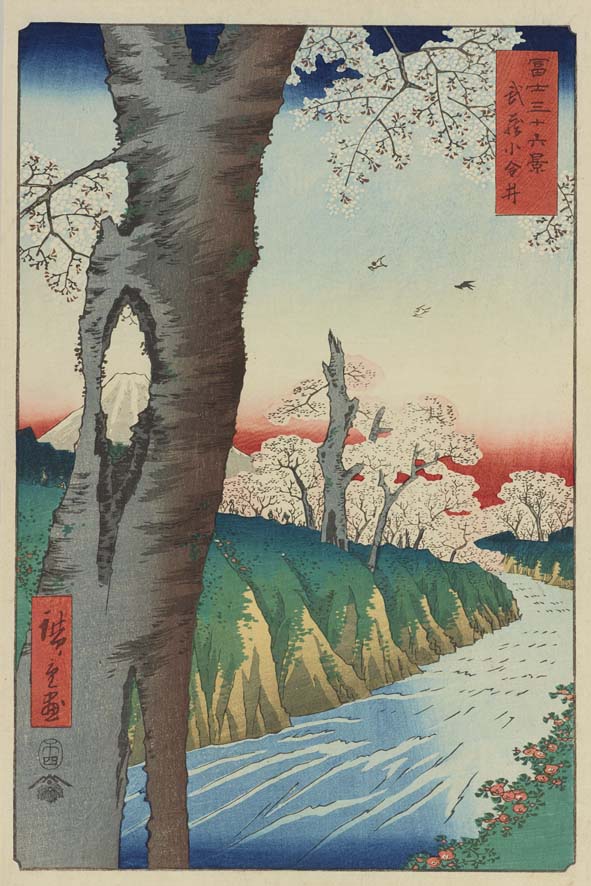
Utagawa Hiroshige “Thirty-six Views of Mt. Fuji : View from Koganei in Musashi Province”(Exhibited in the 1st term)
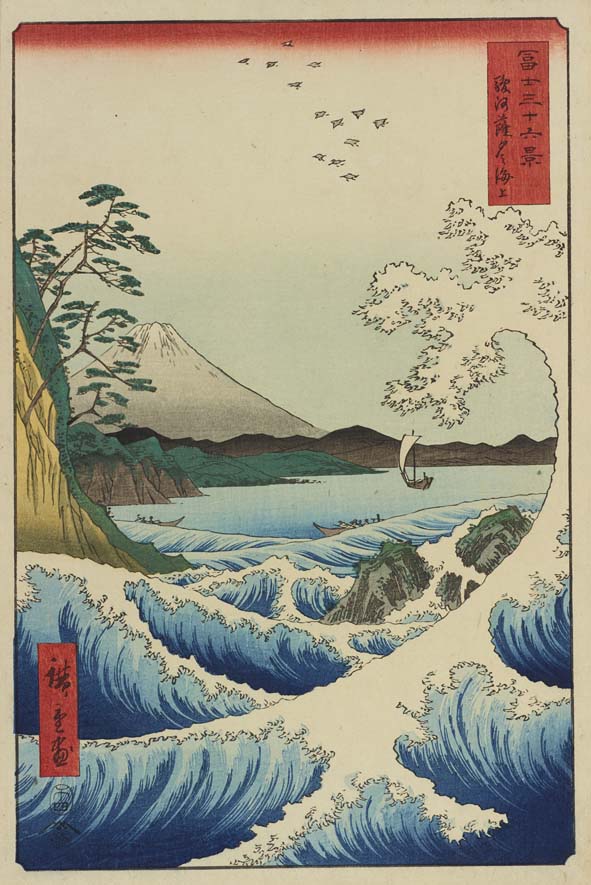
Utagawa Hiroshige “Thirty-six Views of Mt. Fuji :Sea off Satta in Suruga Province” (Exhibited in the 2nd term)
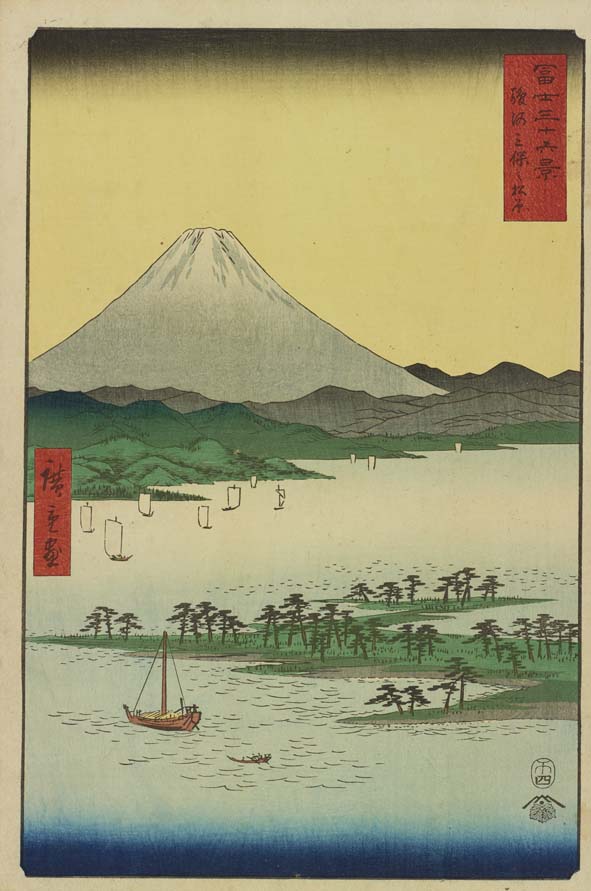
Utagawa Hiroshige “Thirty-six Views of Mt. Fuji : Pine Forest of Miho in Suruga Province”(Exhibited in the 2nd term)
Series of “Thirty-six Views of Mt. Fuji” by Hiroshige in his later years
After the huge success of the series “Fifty-three Stations of the Tōkaidō Road,” Hiroshige continued to create many works as one of the leading artists of landscape pictures. “Thirty-six Views of Mt. Fuji” is his masterpiece in his later years. According to the index inscribed onto the works, Hiroshige created rough sketches of this series in 1858 and published it in the following year. Although the theme of this series is the same as of rivaling artist, Hokusai’s “Thirty-six Views of Mt.Fuji”, the Hiroshige’s calm depiction of Mt. Fuji marks a distinction from Hokusai’s style.
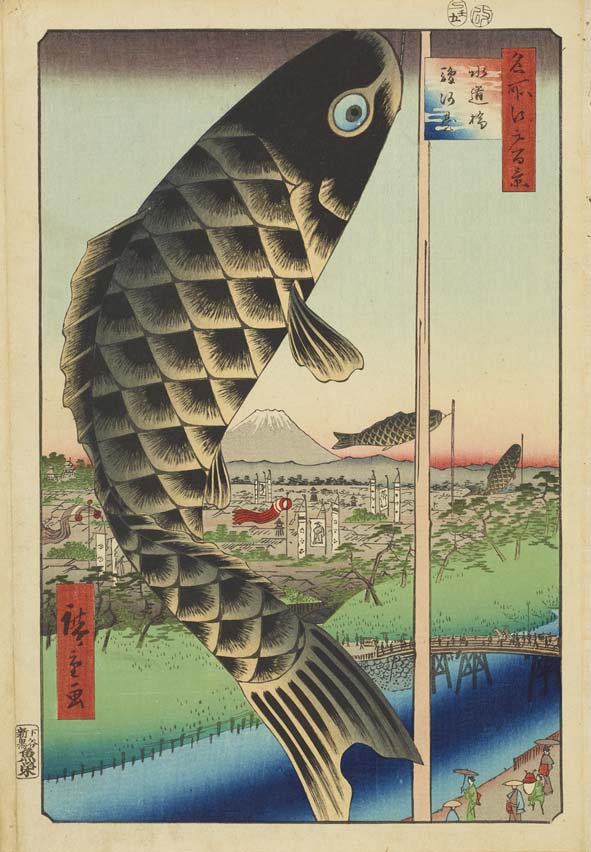
Utagawa Hiroshige “One Hundred Famous Views of Edo :Suidōbashi Bridge and Surugadai” (Exhibited in the 1st term)
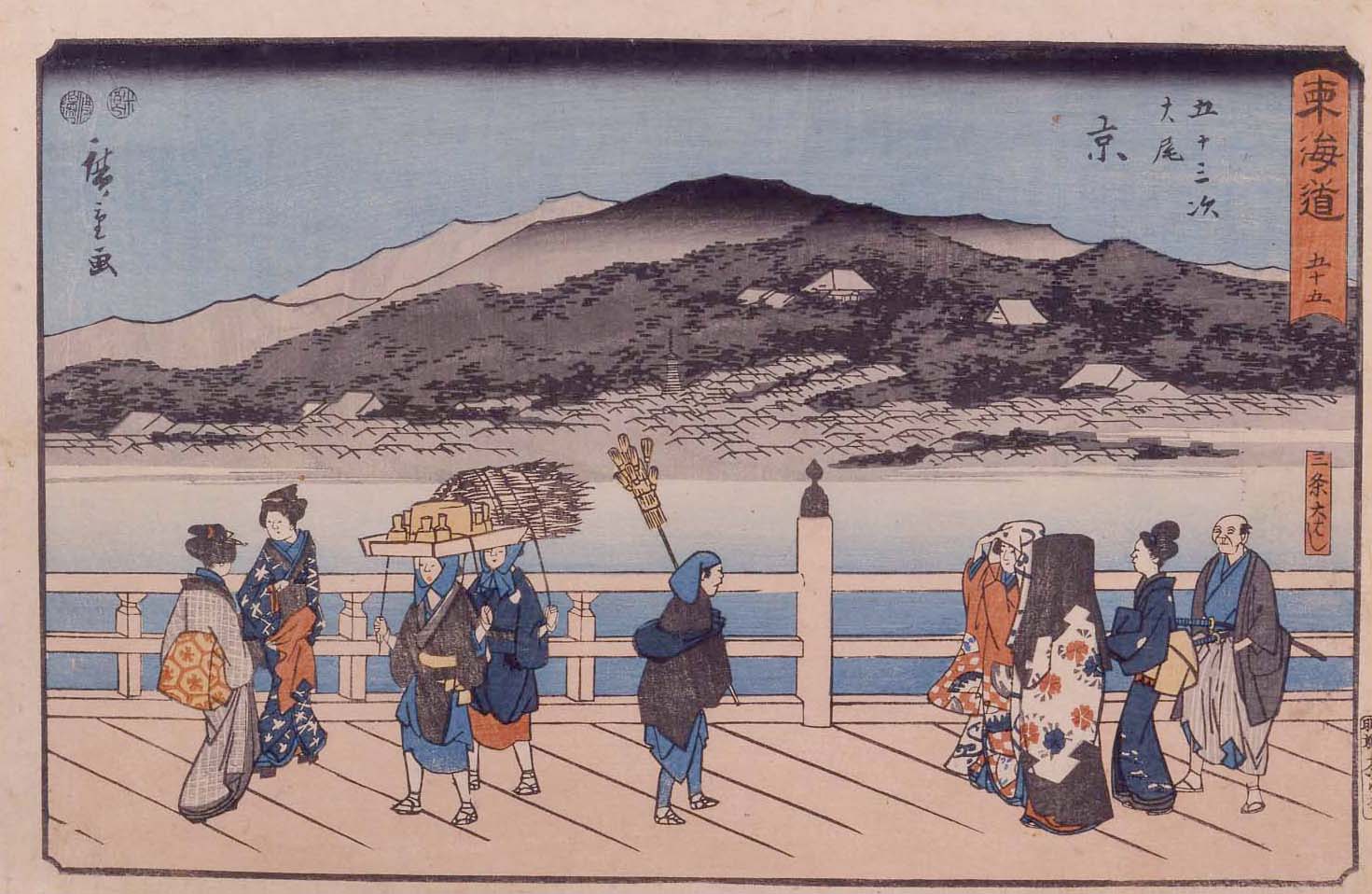
Utagawa Hiroshige “Fifty-three Stations of the Tōkaidō Road: Keishi(Kyoto), Sanjō Ōhashi Bridge” (Exhibited in the 2nd term)
During the same period as this exhibition, “The Hara Yasusaburo Collection- HIRISHIGE VIVID” will be held at the Suntory Museum of Art starting April 29th. This exhibition will focus on two series of famous pictures by Hiroshige, “One Hundred Famous Views of Edo” and “Famous Views in the Six-odd Provinces”. By visiting both museums, people can enjoy the four celebrated series of Hiroshige art all in one period: “Fifty-three Stations of the Tōkaidō Road”, “Famous Views in the Six-odd Provinces”, “One Hundred Views of Edo”, and “Thirty-six Views of Mt.Fuji”. We offer a mutual discount of the entrance fees for both museums: you are welcome to enjoy a whole collection of Hiroshige at the Ōta Memorial Museum of Art and the Suntory Museum of Art, both located along the Chiyoda subway line.
<Highlight Work of Exhibition>
①Utagawa Hiroshige “Fifty-three Stations of the Tōkaidō Road: Nihonbashi in the Morning” (Exhibited in the 1st term)
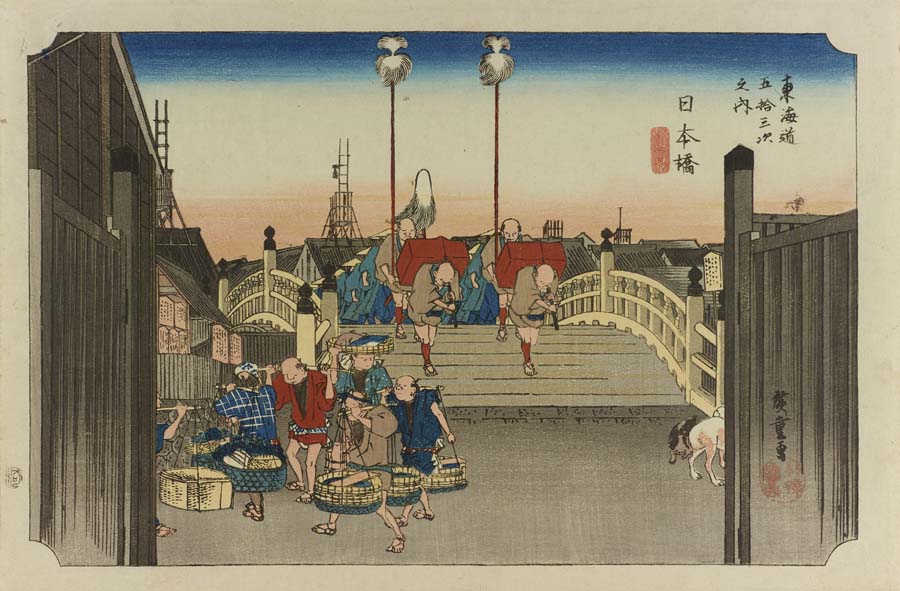
Picture ① depicts the scenery of Nihonbashi, the starting point of the five highways including the Tōkaidō road. As in the title of the picture “Nihonbashi in the Morning” this pictures depicts a scene of Sankinkōtai (a mandatory request for the daimyō to see the shogunate in Edo) crossing Nihonbashi in the early morning. On the right-hand of picture are two puppies depicted in the shadow of the gate. Behind the gates are the place where criminals faced public humiliation. The left side of the picture shows the fish sellers making space for the Sankinkotai to pass. The board indicates a message from the Tokugawa shogunate.
②Utagawa Hiroshige “ Fifty-three Stations of the Tōkaidō Road: Nihonbashi “ (Suntory Museum pf Art/Exhibited in the 1st term)
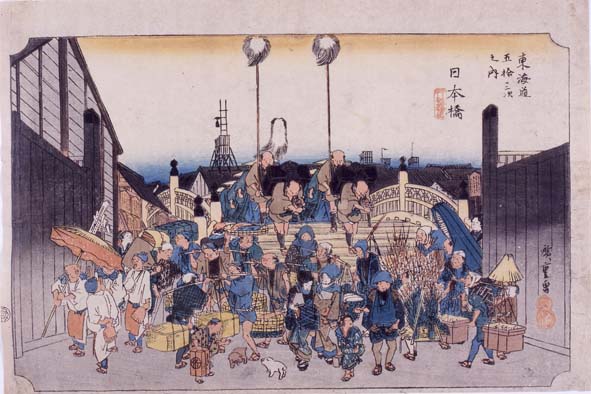
Let’s look at the picture ②. Though this picture looks similar to picture ①, the title is different. This picture is the so-called kawari-zu which is usually picture that is slightly different from the original picture. Like in picture ①, the row of daimyōs can be seen in the back. Yet, those depicted in the front are greater in number. Flower sellers, young Buddhist disciples, and troups dancing the Sumiyoshi Odori can be seen. In the middle is the brown dog around the wooden door from picture ①.
“Fifty-three Stations of the Tokaido Road” is thought to have been long-seller, and multiple similar drawings with minute differences, called kotoban, exist. Among those, this is an interesting picture where big design changes have been made.
Translation Supervised by Japanese Students Association of Princeton University
Admission
| Adult | 700yen |
|---|---|
| University and High school students | 500yen |
| Junior High School Students and below | Free |
Calendar
Closed
- May
SUN MON TUE WED THU FRI SAT 1 2 3 4 5 6 7 8 9 10 11 12 13 14 15 16 17 18 19 20 21 22 23 24 25 26 27 28 29 30 31 - June
SUN MON TUE WED THU FRI SAT 1 2 3 4 5 6 7 8 9 10 11 12 13 14 15 16 17 18 19 20 21 22 23 24 25 26 27 28 29 30
“Utagawa Kunisada ~Japanese Lifestyle and Fashion”
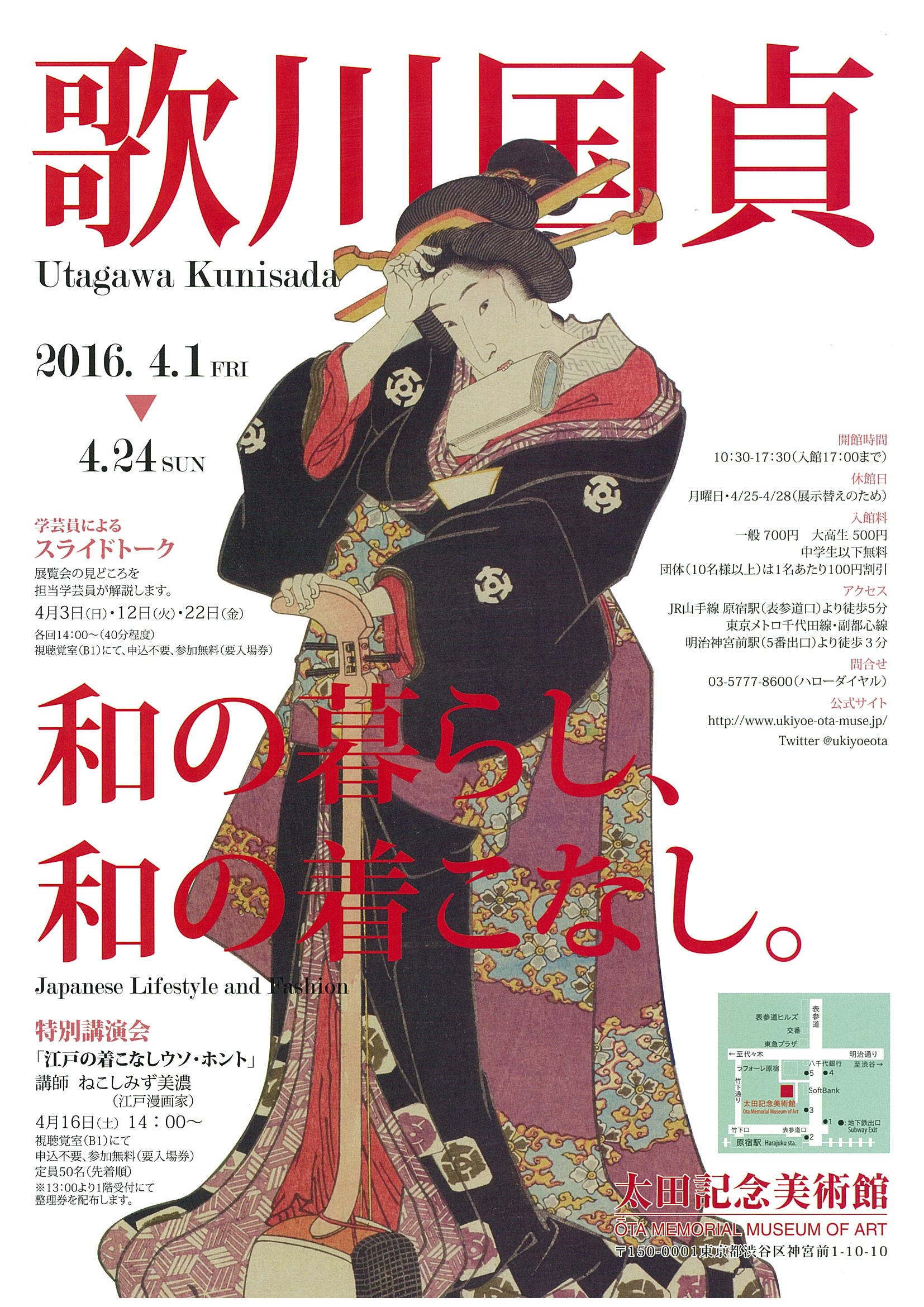
2016, April 1~24th
(will be closed on April 4, 11 and 18th)
Leading Artist, Utagawa Kunisada who Depicted the Lifestyle of Edo People
Utagawa Kunisada (1786-1864) was the leading ukiyo-e artist of his time. His popularity was far greater than that of Hokusai, Hiroshige, and Kuniyoshi. While Kunisada not only has the largest number of works for kabuki-actor portraits, but also has left many artworks depicting the lifestyle of the Edo people. He is an invaluable artist who visually transmits the life style of Edo to viewers today.
Enjoying Japanese Lifestyle and Fashion
Kunisada‘s ukiyo-e captures Japanese lifestyles from a wide variety of angles. Portrayed in his works are people who are relishing the beauty of nature during seasonal transitions, enjoying a delicious meal, making music, and fondling a cat. Also pay attention to the women, whose appearances give us a glimpse into the clothing and make-up trends of the time. Through his art, Kunisada brings out the vibrant lifestyles and fashions of Japanese culture.

“Thirty-two Contemporary Appearances: Looking Cool” Refreshing by Taking a Bath

“Twenty-four Tastes of Modern Beauties : Lover of Sweets” Loving Sweets

“One Hundred Beauties with the Inset of the Famous Places of Edo: Hikawa Shrine, Playing Koto” Practicing a Koto (thirteen-stringed Japanese musical instrument)

“Comparison of Favorite Modern Actors : Woman Holding a Cat”
Giving a Collar to a Cat

“Collection of Contemporary Beauties : High-ranking Courtesan” Gorgeous Hair Ornaments

“One Hundred Beautiful Women at the Celebrated Places in Edo: Woman at Imagawa-bashi Bridge”Caring Hair Elaborately
<Highlight Work of Exhibition>
”One Hundred Beautiful Women at
the Celebrated Places in Edo: Yoshichō”

Rakish Standing Posture of Geisha
Translation Supervised by Japanese Students Association of Princeton University
Admission
| Adult | 700yen |
|---|---|
| University and High school students | 500yen |
| Junior High School Students and below | Free |
Calendar
Closed
- 2016, April
SUN MON TUE WED THU FRI SAT 1 2 3 4 5 6 7 8 9 10 11 12 13 14 15 16 17 18 19 20 21 22 23 24 25 26 27 28 29 30
“Katsukawa Shunshō -Master of Hokusai”

[2nd Term] March 4th ~27th
※Will be closed on February 8,15,22,29th / March 1~3,7,14,22nd
The Master of Hokusai, The Origins of Sharaku
Unearthing the Unnamed Titan, Katsukawa Shunshō, and His Career as an Artist

Katsukawa Shunshō “Kabuki Actors, Ichikawa Danjūrō Ⅴ as Matano no Gorō Kagehisa, Nakamura Rikō Ⅰas Courtesan, Shirabyōshi Kazaori and Sawamua Sōjūrō Ⅲas Kawazu no Saburō Sukeyasu” (Exhibited in the 2nd term)
1. Roots of Sharaku ―Pioneer of the Kabuki Actor Portrait
Katsukawa Shunsho, begins to concentrate his work on portraits of Kabuki actors in the Meiwa era (1764-1772). In collaboration with Ippitsusai Buncho, the style they produced was unlike the Torii style of art which was popular at the time. This art depicted the face, body, and costume of Kabuki actors in a very realistic manner. This new style of realistic portraits of the actors’ bodies and clothes by the Katsukawa school become the new mainstream for Kabuki portraits, and here is where disciples such as Katsukawa Shunko, Katsukawa Shunei, Toshusai Sharaku, and Utagawa Toyokuni thrived. In that sense, it can be said that much of the popularity of Kabuki art throughout the late Edo period can be attributed to Shunsho’s success.
Katsukawa Shunshō “Kabuki Actors, Ichikawa DanjūrōⅤ as Sakata no Kintoki and Segawa KikunojōⅢas Kumo no sei Disguised as Maiko, Tsumagiku” (Exhibited in the 1st term)

Katsukawa Shunkō ”Kabuki Actor, Ichikawa MonnosukeⅡ as Soga no Gorō”(Exhibited in the 1st term)

Tōshūsai Sharaku “Kabuki Actor, Ichikawa EbizōⅠ as Takemura Sadanoshin”(Exhibited in the 2nd term)
2.Endless Challenge –Sumo-e (pictures of sumo wrestlers) ・Bijin-ga (pictures of beautiful women)・Musha-e (warrior picture)
Shunsho’s career as an artist started late, and is estimated to have begun when he was around forty years old. Portraits of Kabuki actors by Shunsho and the Katsukawa school of art gained much popularity, but Shunsho was not satisfied with it, and worked on many other genres such as Bijin-gas (portraits of beautiful women) and Musha-es (warrior portraits). Among those were the works he produced in his fifties, such as sumo-e which is said to have been established as a genre by Shunsho, and nikuhitsu-bijinga paintings, allowing us to observe Shunsho’s mentality to keep on challenging himself even at an old age.
Katsukawa Shunshō “Two Standing Sumo Wrestlers, Kashiwado Kandayū and Inagawa Masaemon in Ceremonial Wear(Exhibited in the 1st term: Ishiguro Collection)

Katsukawa Shunshō “Smiling Competiton of Ebisu (god of wealth) and a Woman”(Exhibited in the 2nd term)

Katsukawa Shunshō “Ushiwakamaru and Benkei at Gojō Ōhashi Bridge” (Exhibited in the 1st term)
3.Hokusai’s Master and Leader of the Katsukawa School of Art
The charismatic Shunsho attracted many disciples. Katsukawa Shunko, Shunsho’s foremost pupil, faithfully followed his artistic style. Katsukawa Shun’ei was known for his soft, refined painting style, while Katsukawa Shuncho depicted beautiful women in the style of Torii Kiyonaga. While these three are the most famous of Shunsho’s disciples, the renowned ukiyo-e artist, Katsushika Hokusai was once a student of his as well. Hokusai entered the Katsukawa School during his youth and painted under the pseudonym Katsukawa Shunro until he was about 35 years old. Hokusai, said to have eventually disagreed with the older disciples such as Shunko, left the school Shunsho’s death. After much experience afterwards, Hokusai creates his series of masterpieces, such as the “Thirty-six Views of Mt. Fuji,” at over 70 years old.
Katsukawa Shunchō “Cherry-blossom viewing at Asuka-yama” (Exhibited in the 1st term)

Katsushika Hokusai “Thirty-six Views of Mt. Fuji: Great Wave off the Coast of Kanagawa” (Exhibited in the 2nd term)

Katsukawa Shun’ei “Oshie-gata (patchwork-picture design): Makurajishi” (Exhibited in the 2nd term)

Katsukawa Shunrō(Hokusai) “Kabuki Actor, Nakamura Nakazō I ” (Exhibited in the 2nd term)
<Highlight Work of Exhibition>
Katsukawa Shunshō “ July: the Star Festival “
(Exhibited in the 1st term) (C.1764~1772)

The artwork Shunsho presents here is one of July. In the upper right side is the image of the Star Festival, and the bottom left is the market for the bon festival. The Star Festival is still an ongoing event of July today. In this work, the star-festival decorations on the roofs of houses float in the wind under the starry sky. On the right side of the picture depicting the Bon Festival, a flower-seller boy is talking to two women. The dog under the bridge seems to sleep in comfort. This work can be said to be the masterpieces of Shunsho’s early works on bijin-gas.
Translation Supervised by Japanese Students Association of Princeton University
Admission
| Adult | 1000yen |
|---|---|
| University and High school students | 700yen |
| Junior High School Students and below | FREE |
Calendar
Closed
-
2016 FebruarySpecial Exhibition
SUN MON TUE WED THU FRI SAT 1 2 3 4 5 6 7 8 9 10 11 12 13 14 15 16 17 18 19 20 21 22 23 24 25 26 27 28 29 -
2016 MarchSpecial Exhibition
SUN MON TUE WED THU FRI SAT 1 2 3 4 5 6 7 8 9 10 11 12 13 14 15 16 17 18 19 20 21 22 23 24 25 26 27 28 29 30 31
